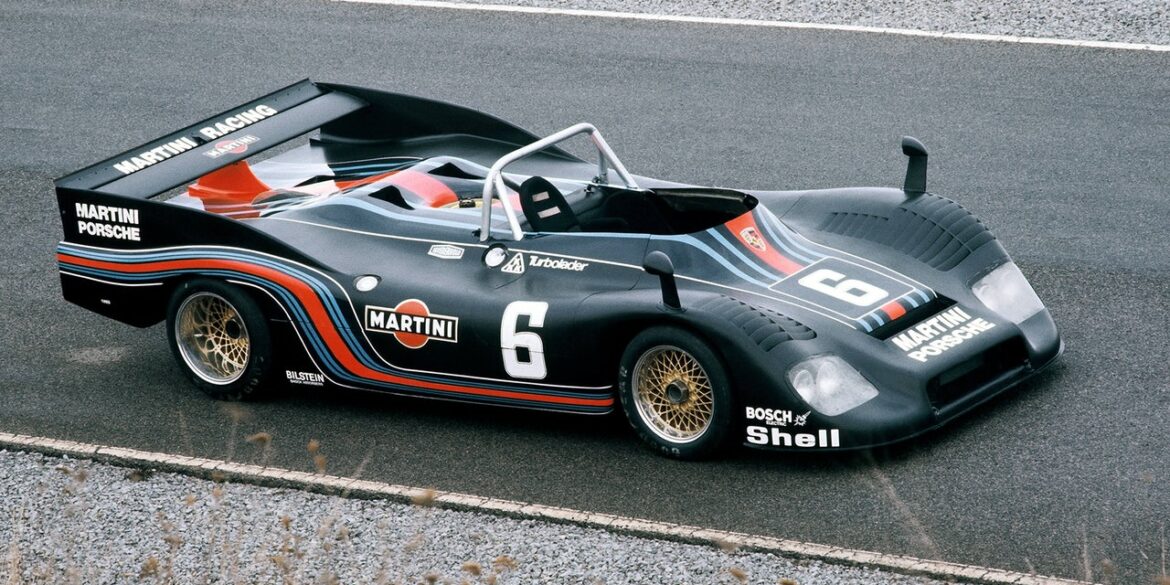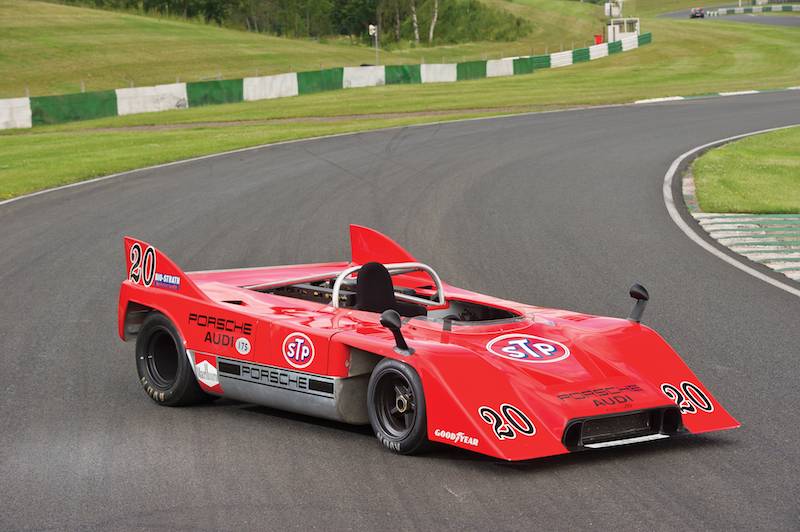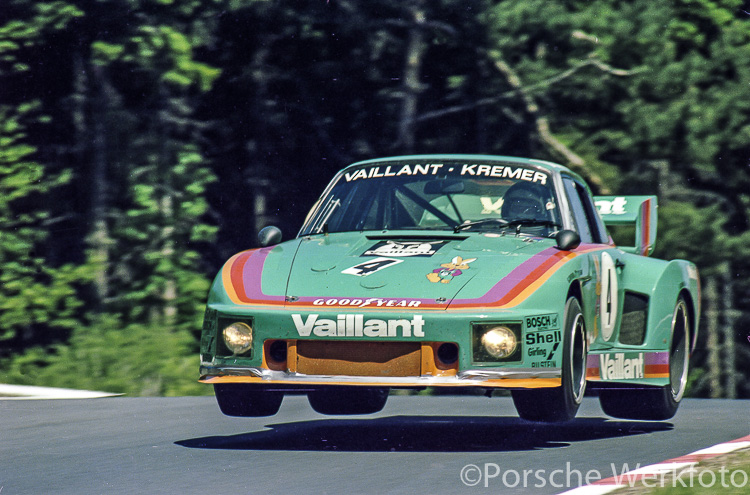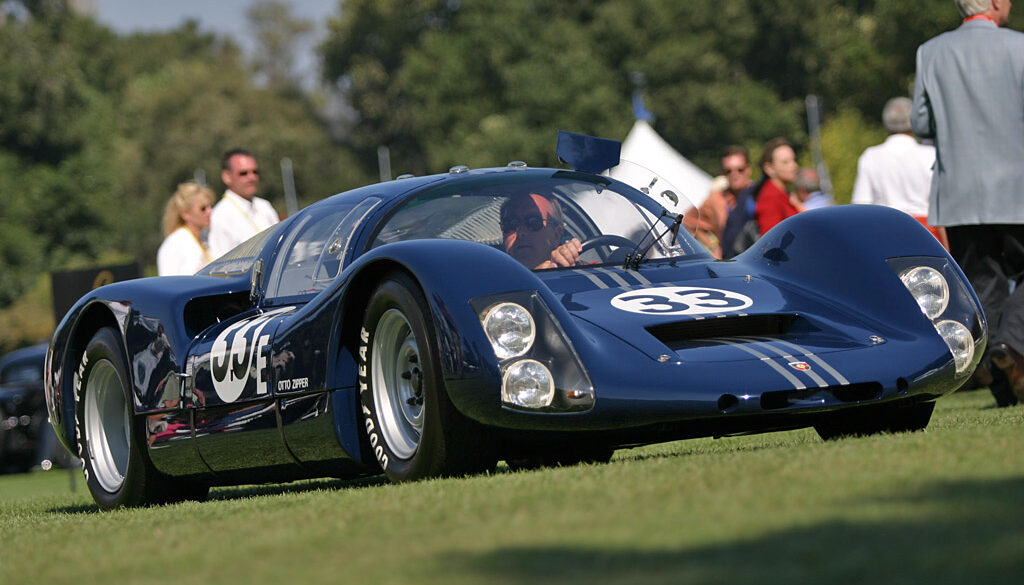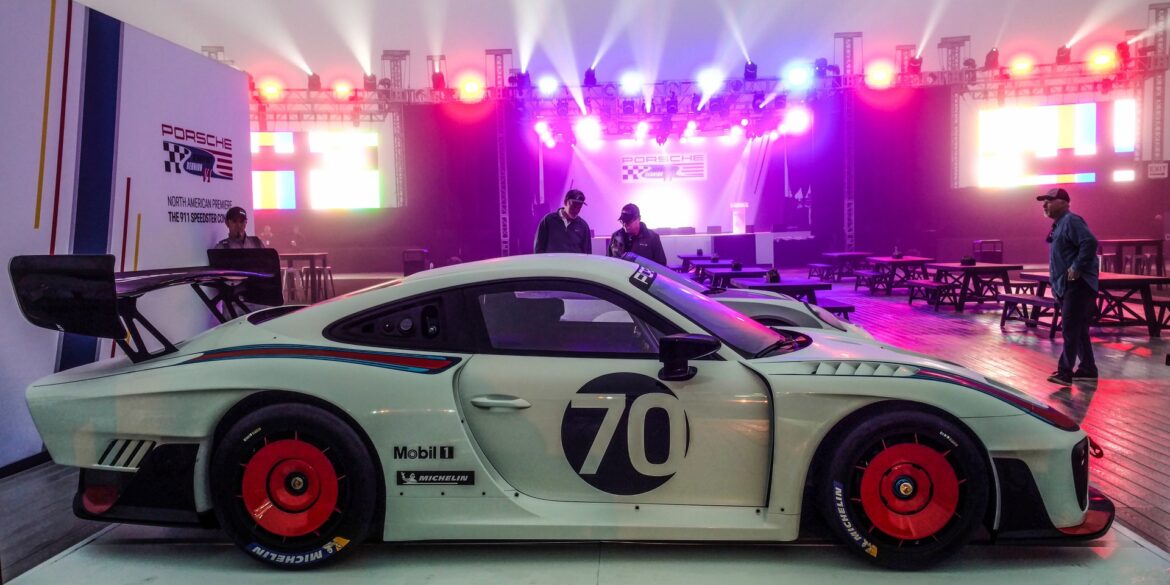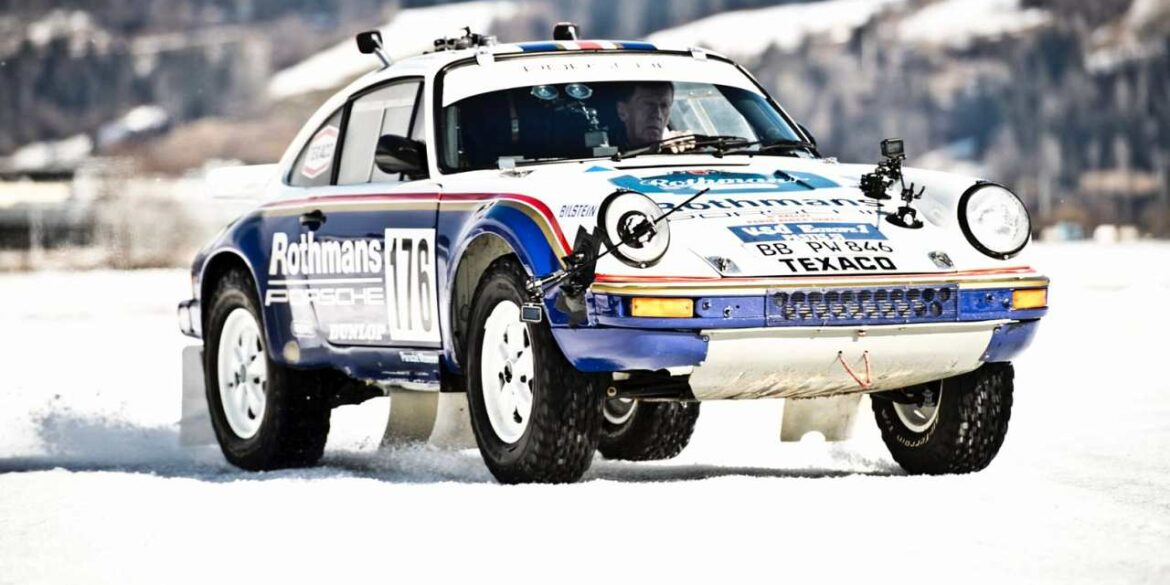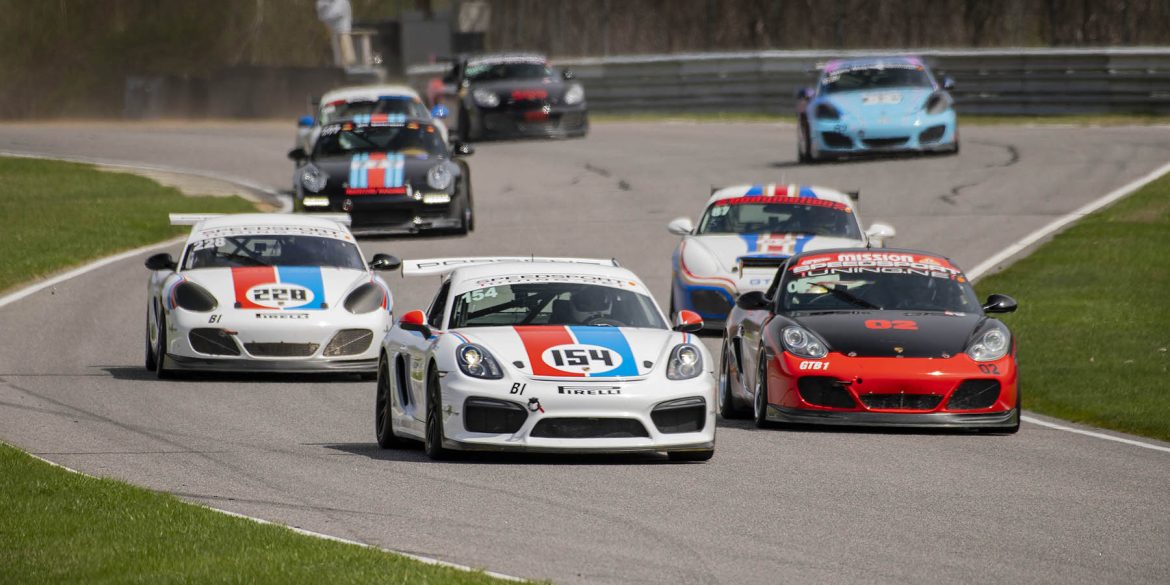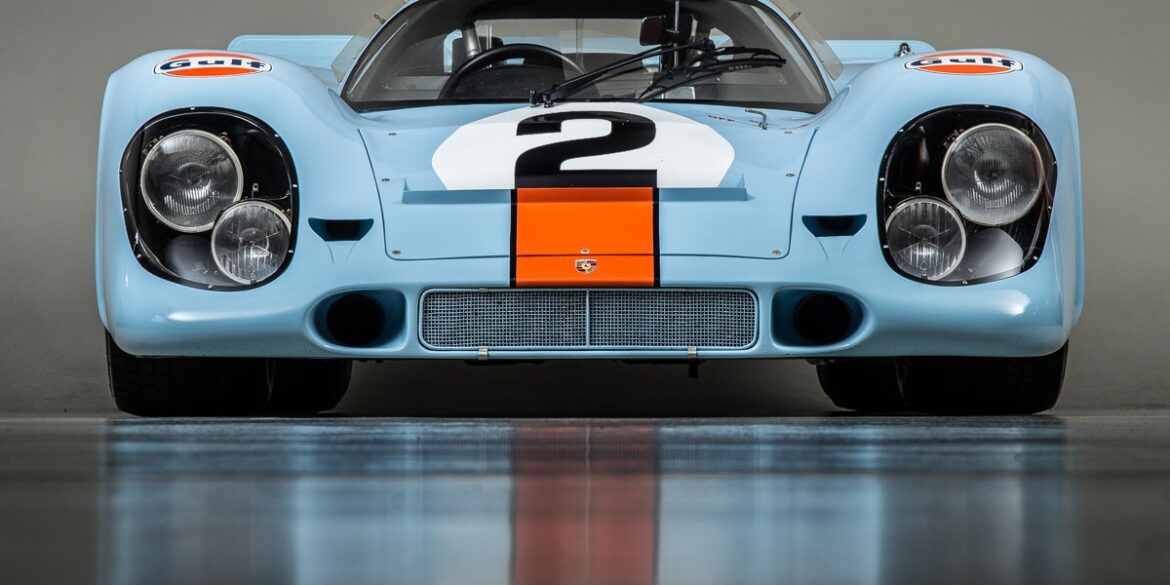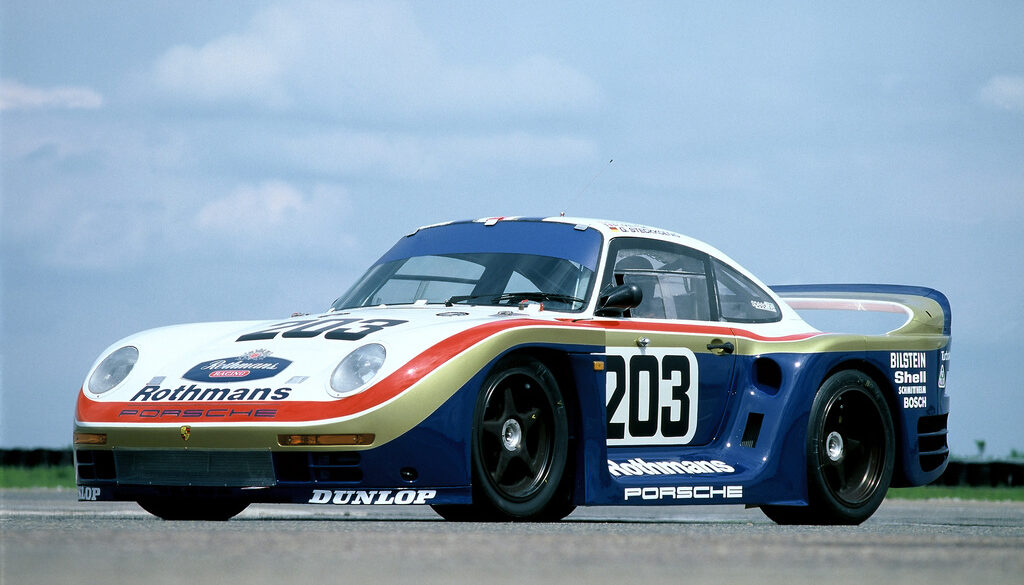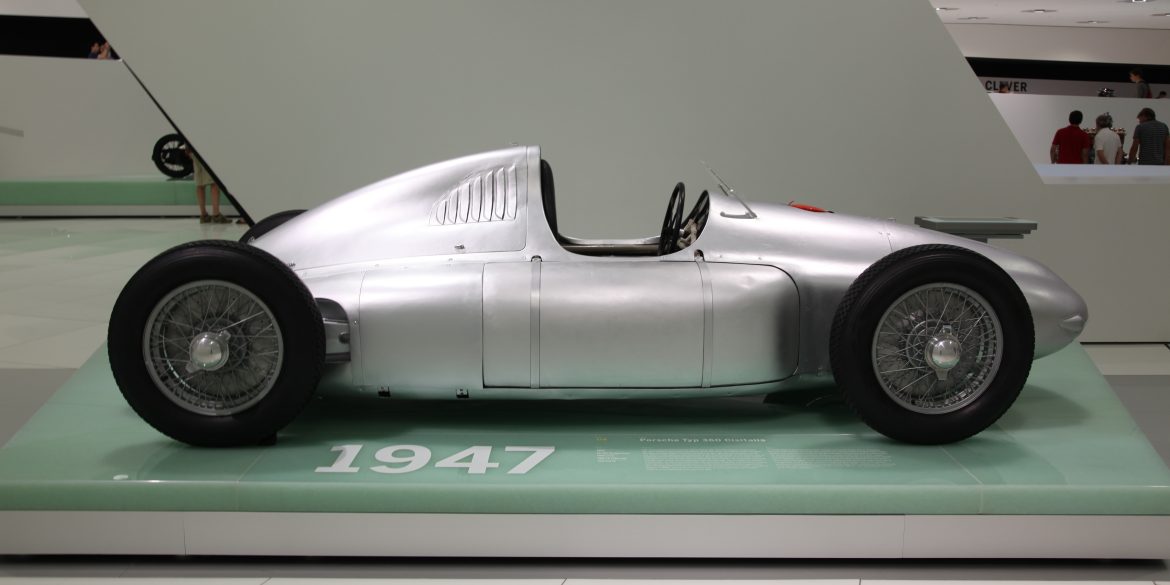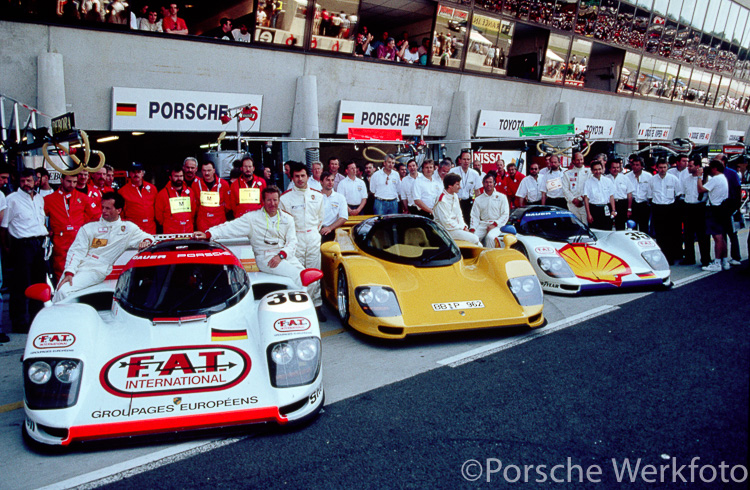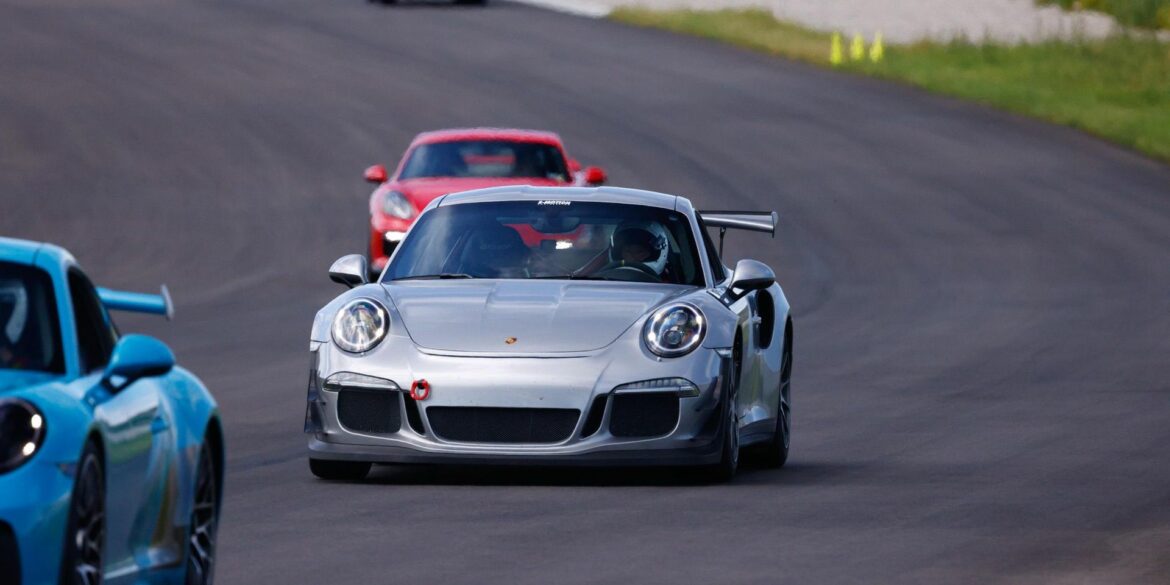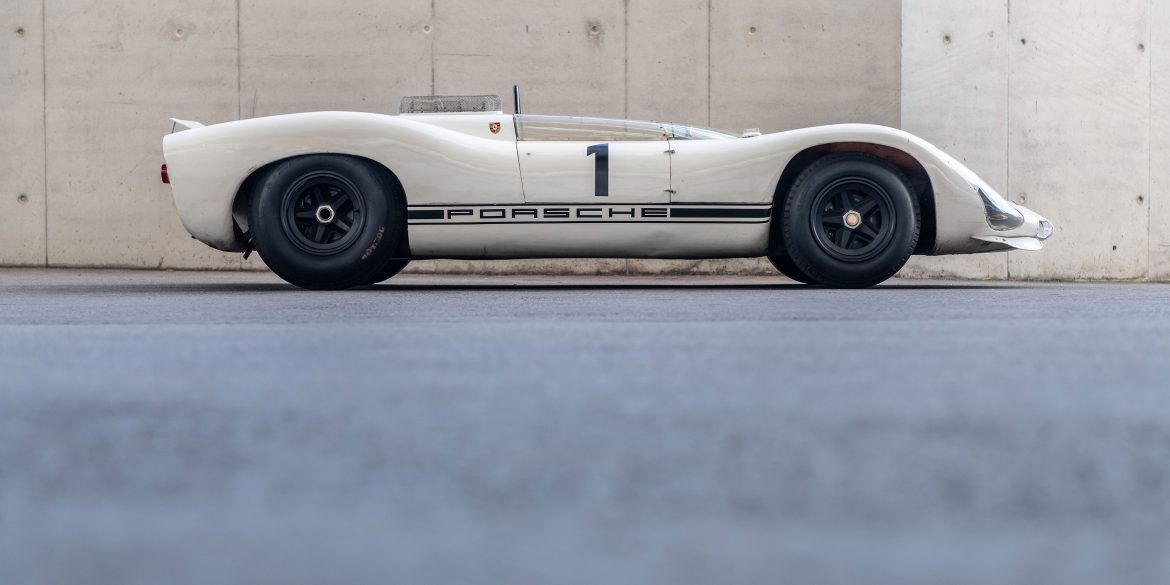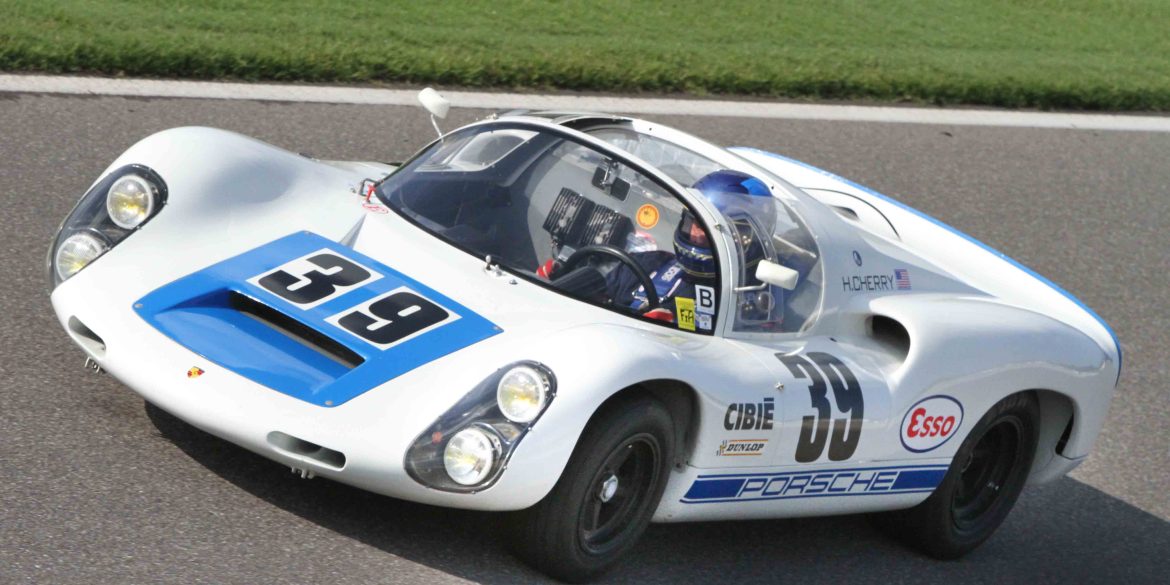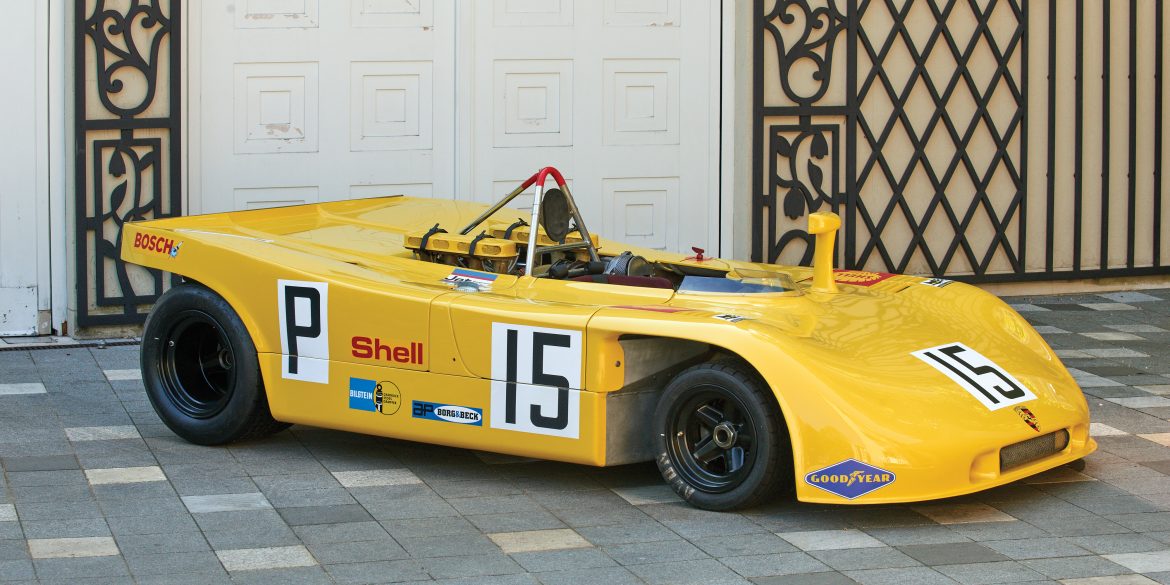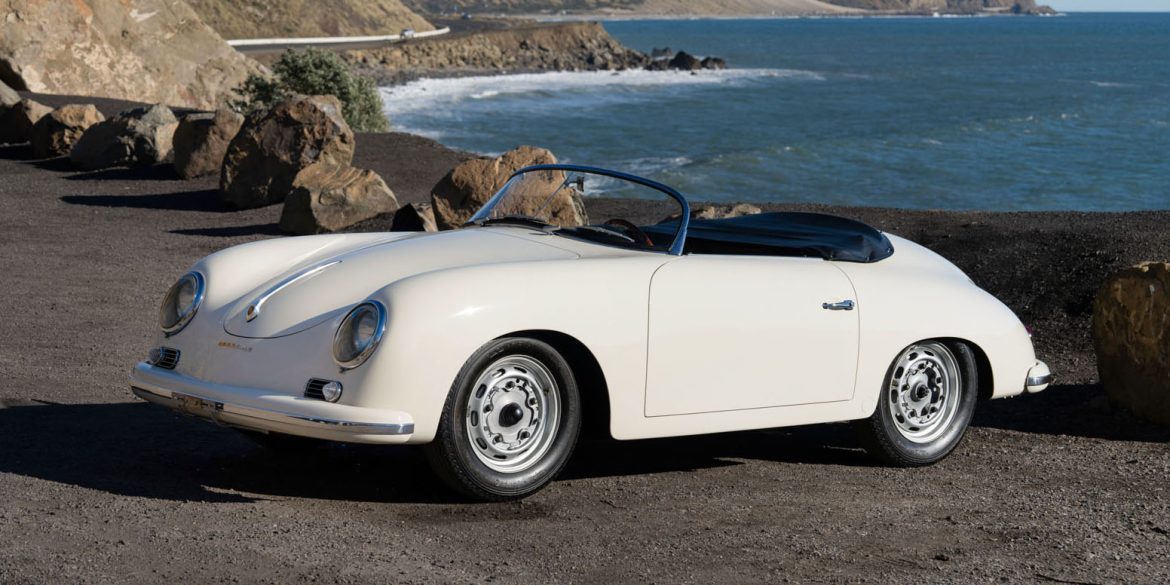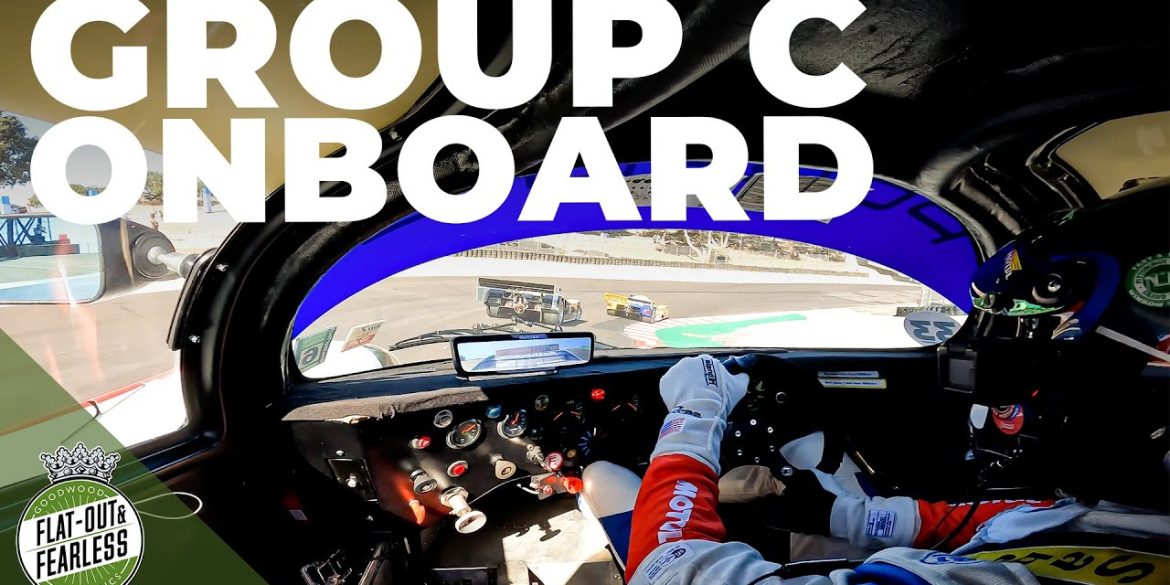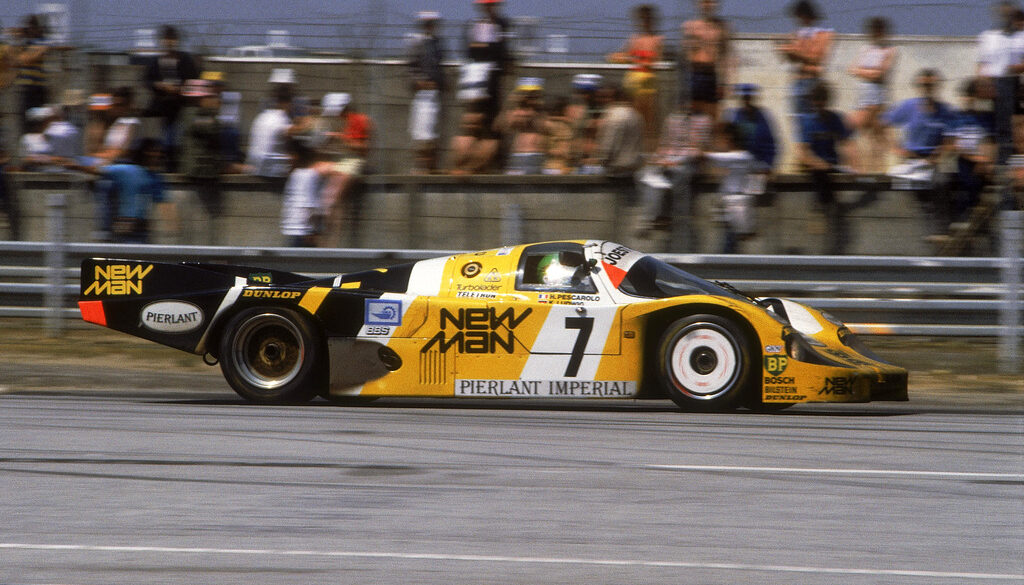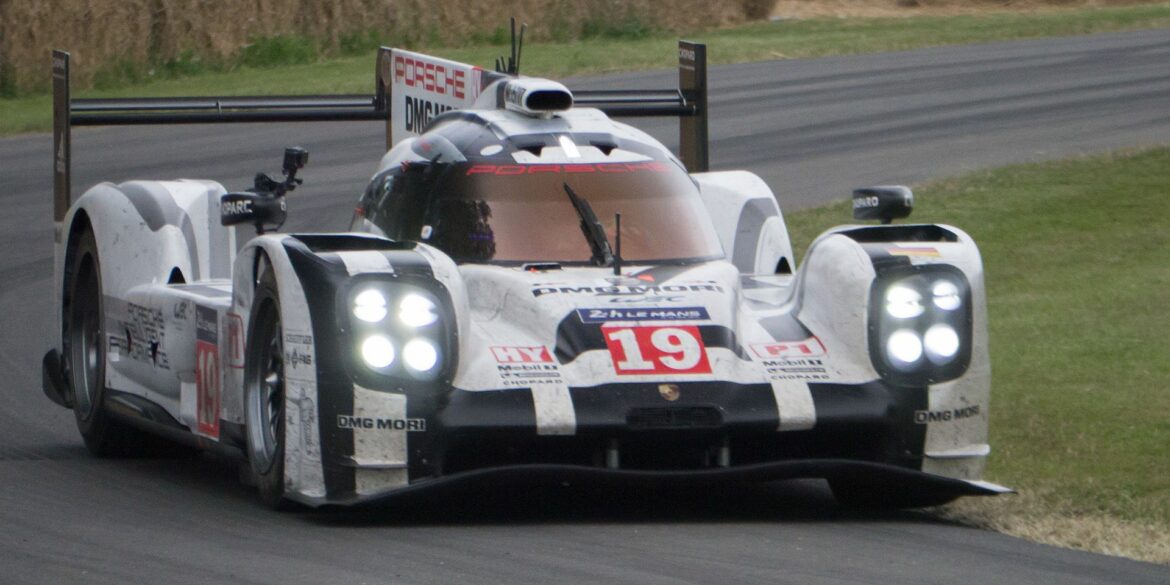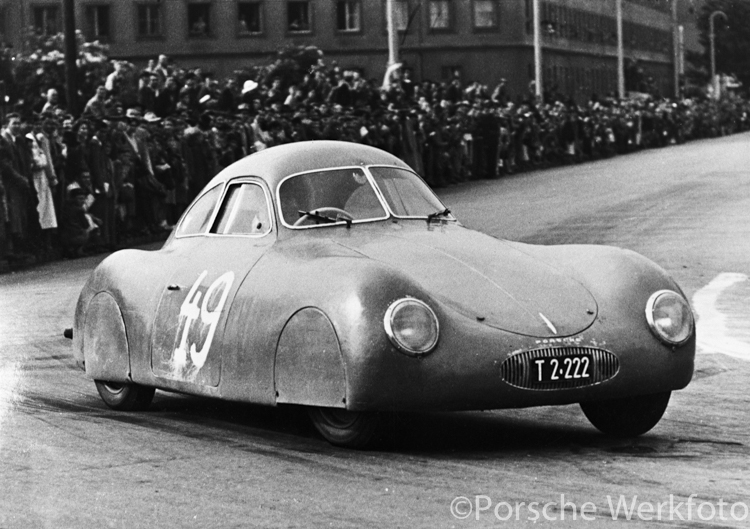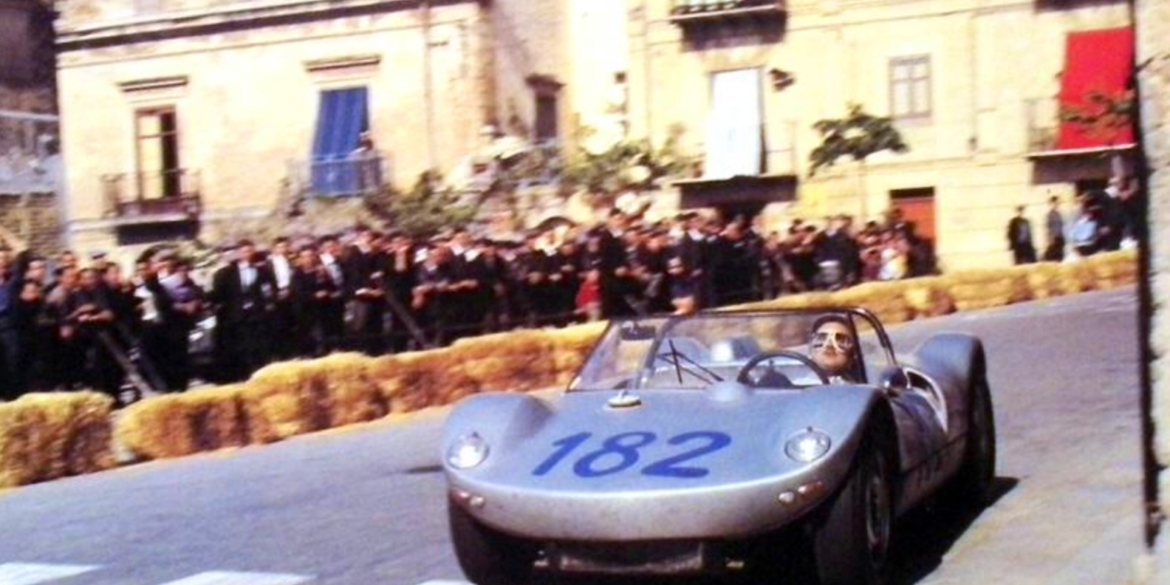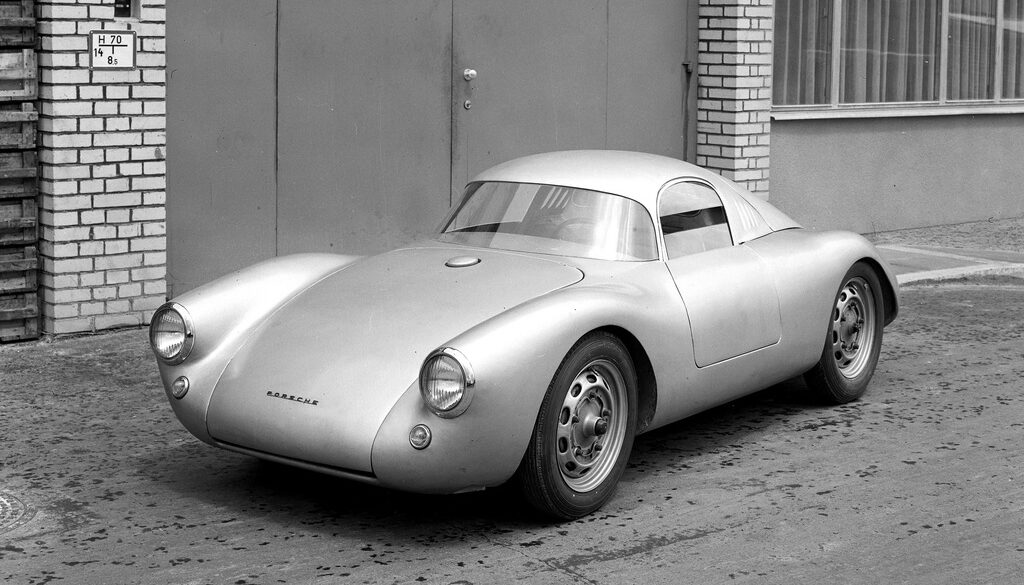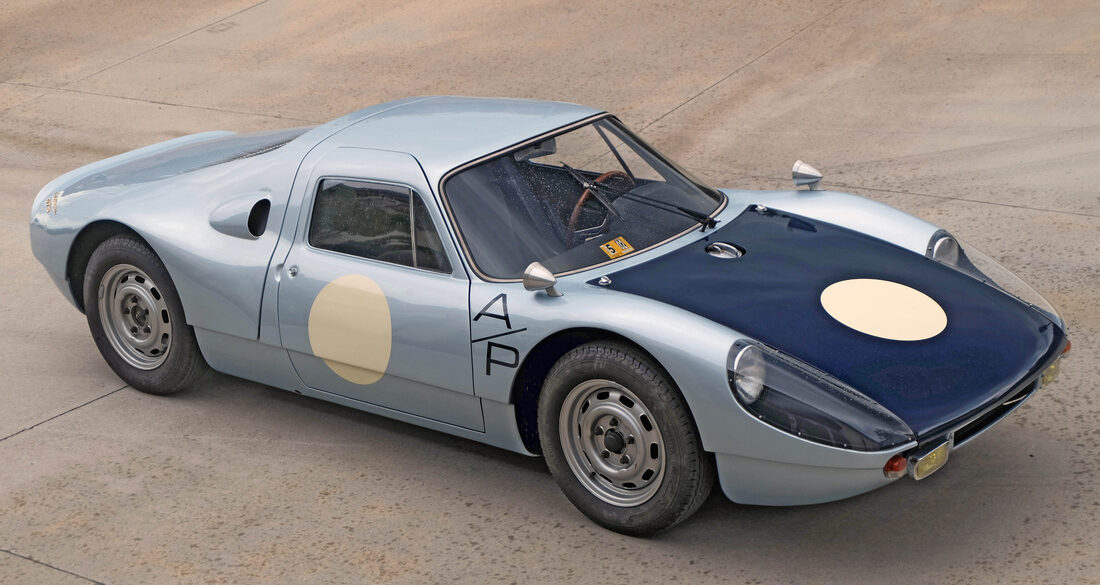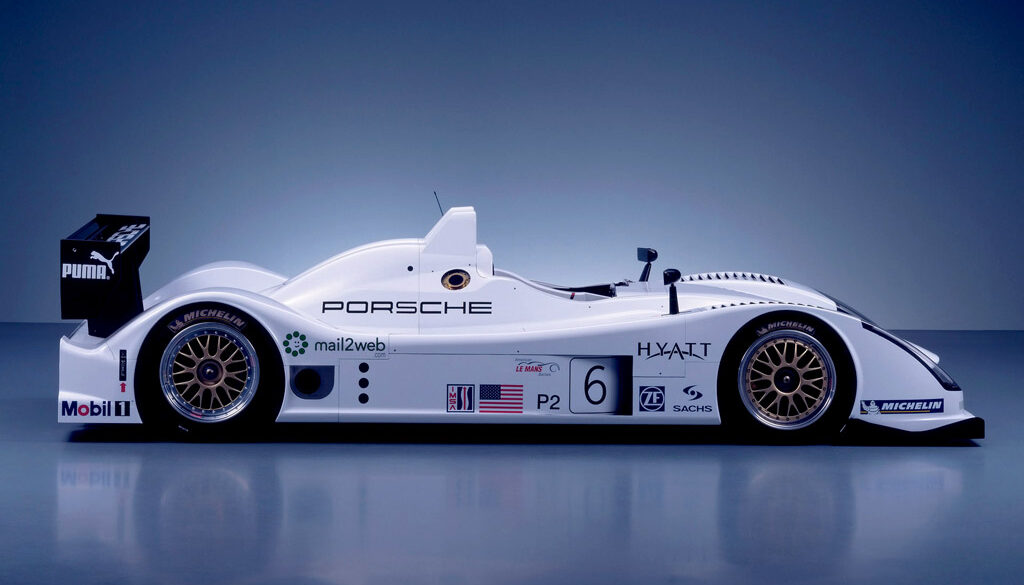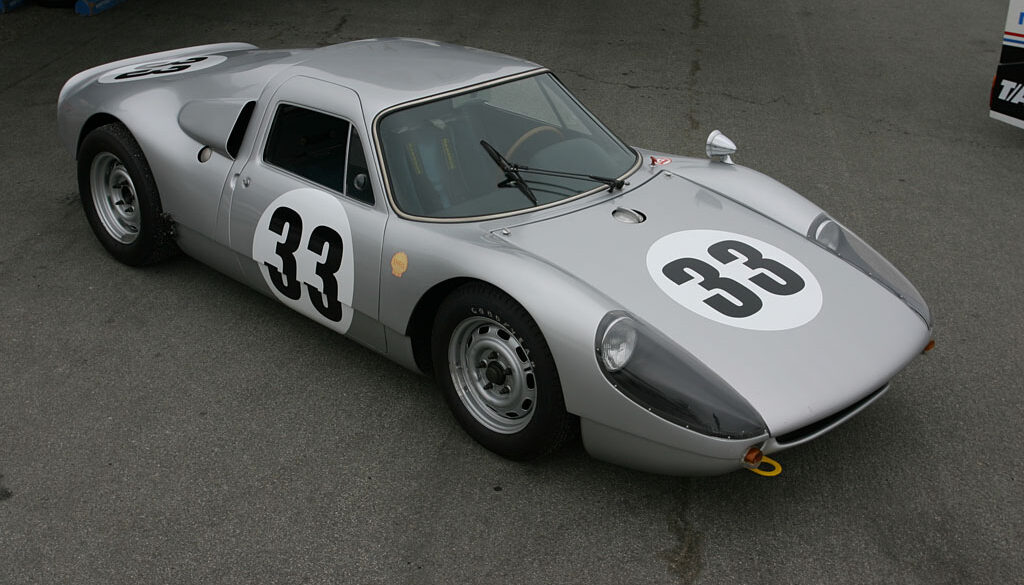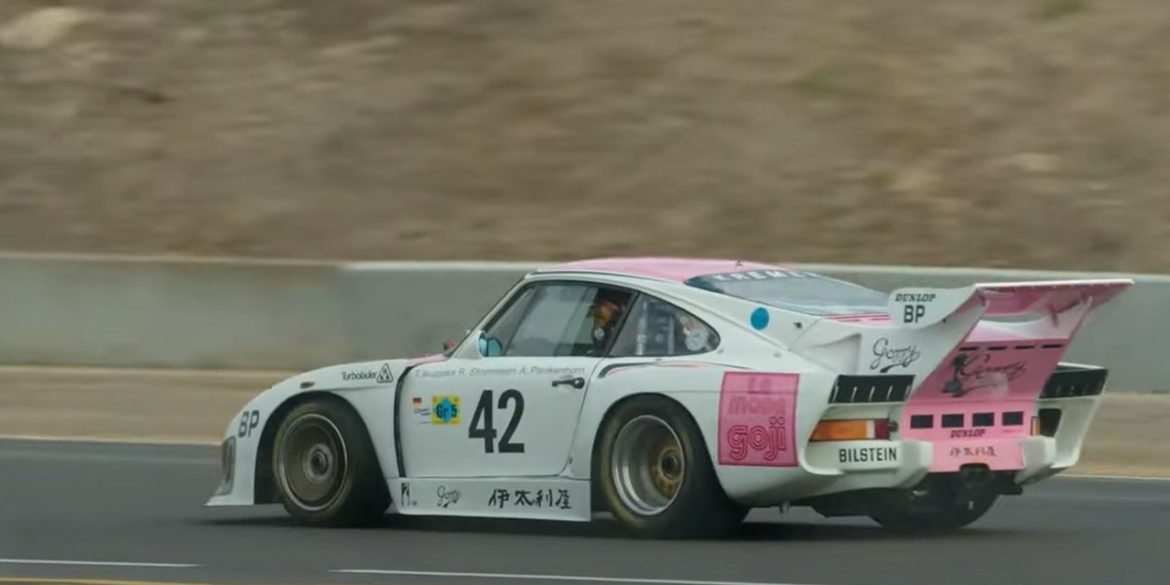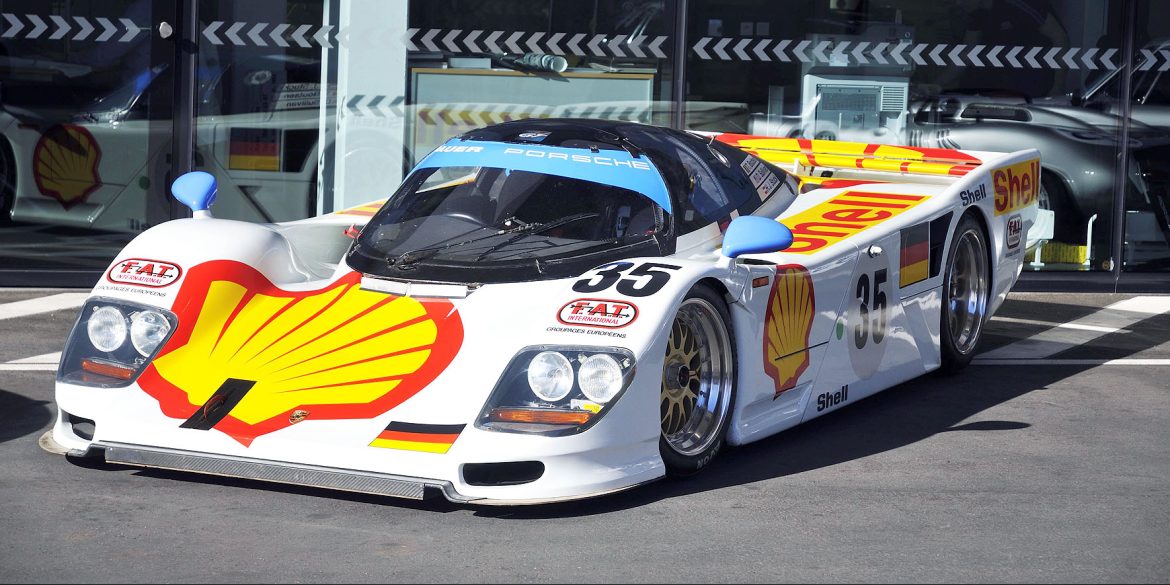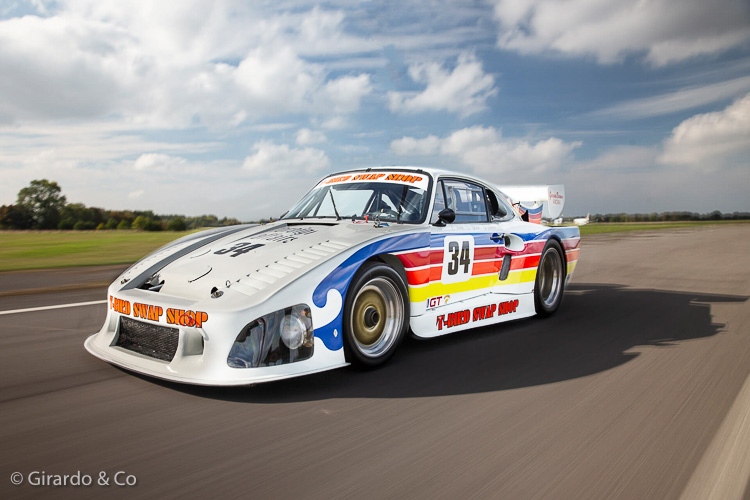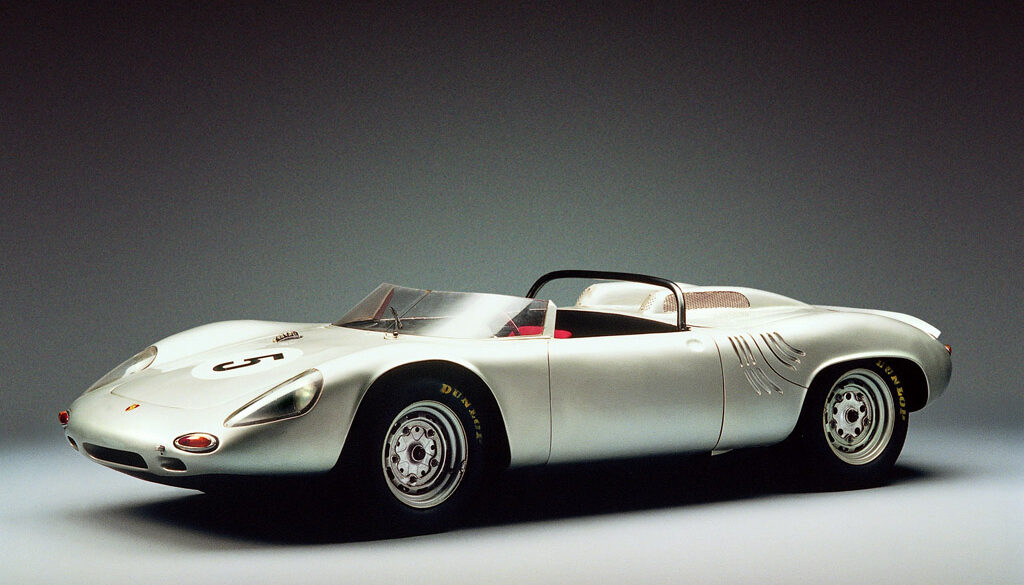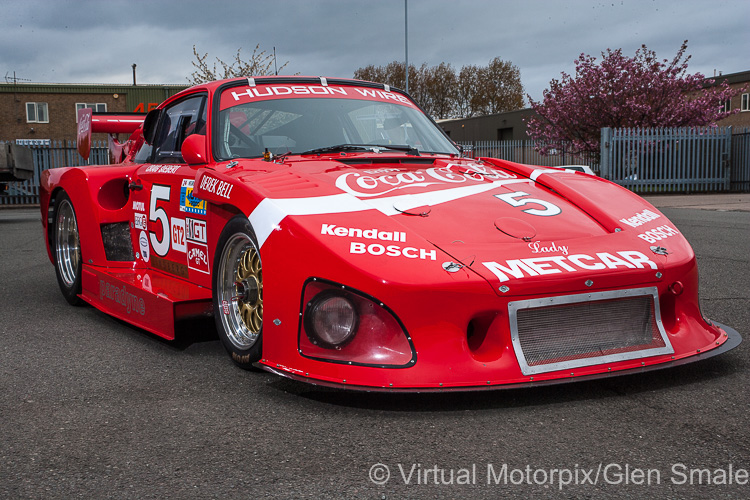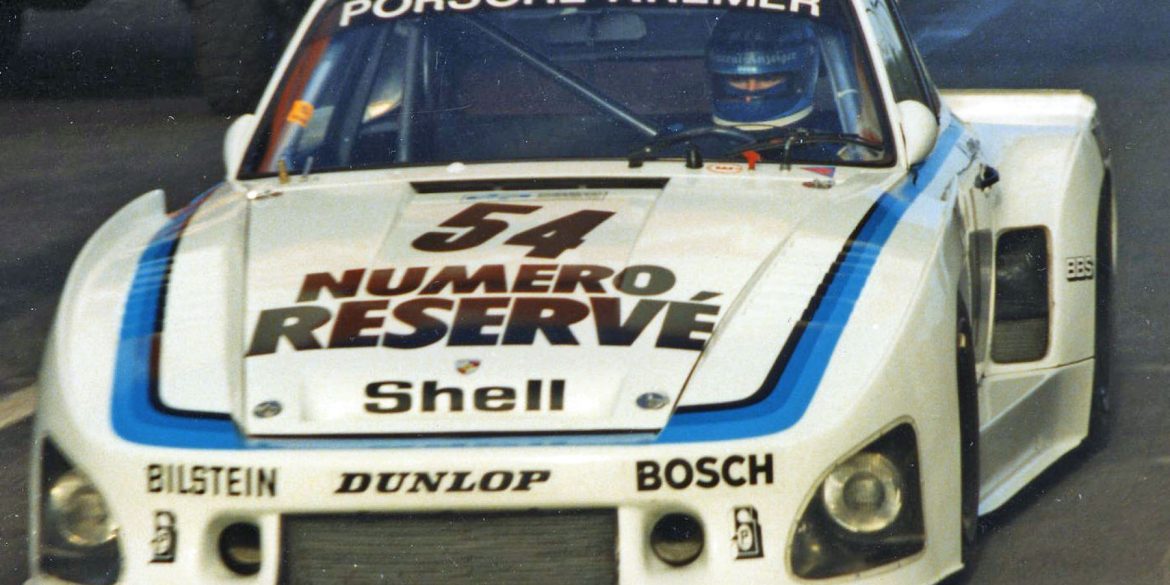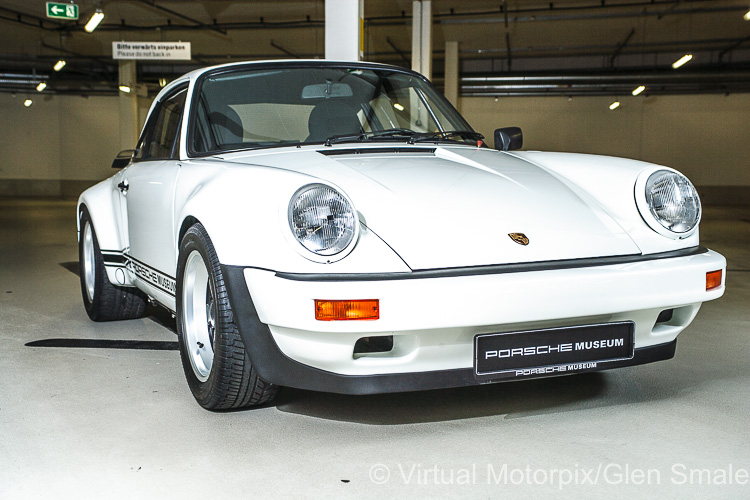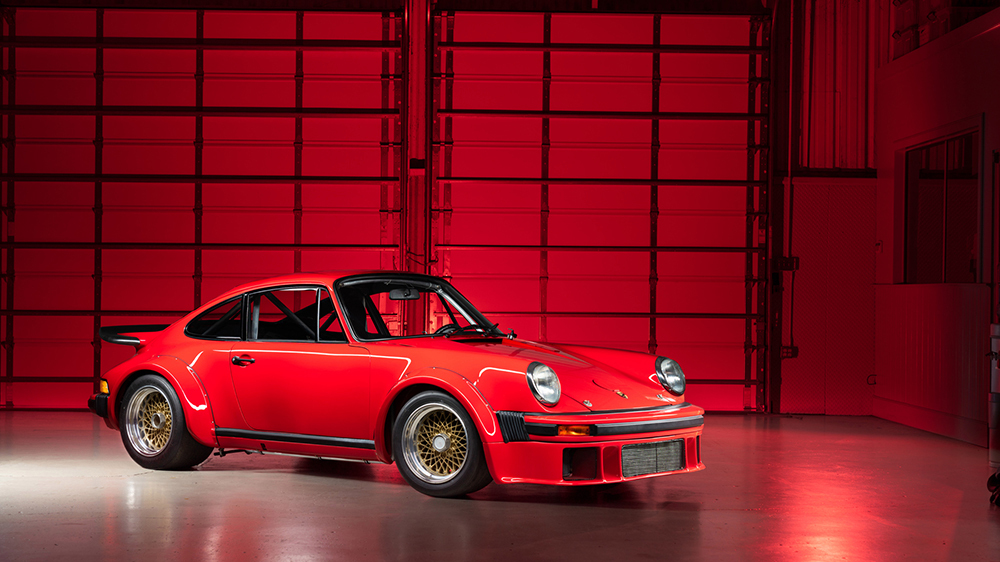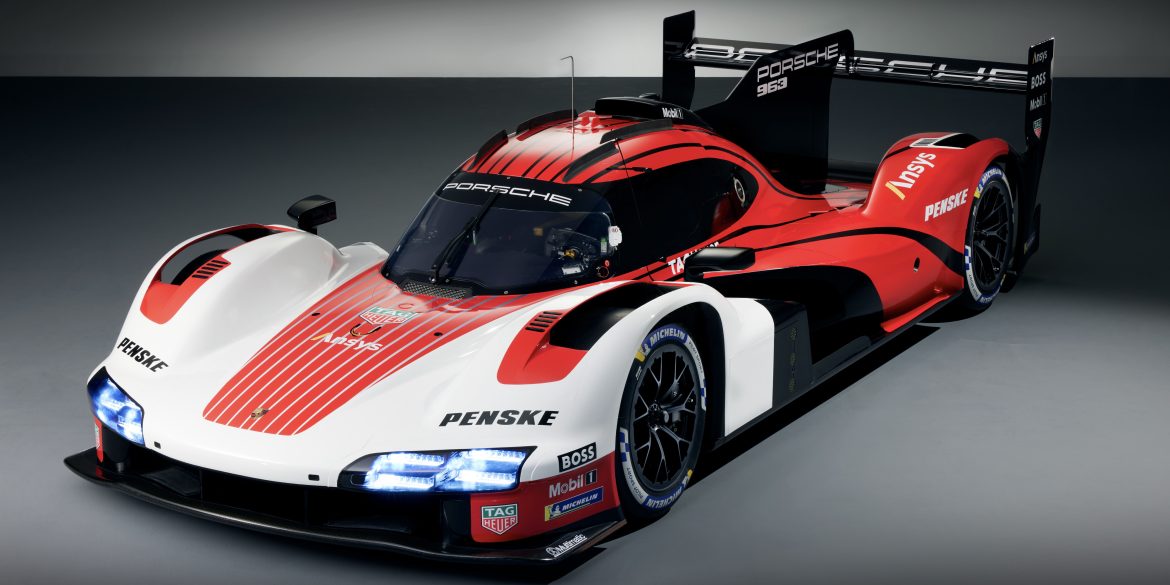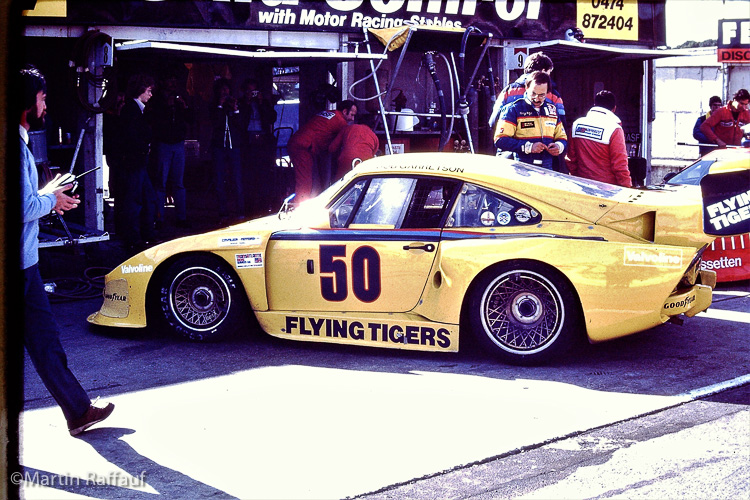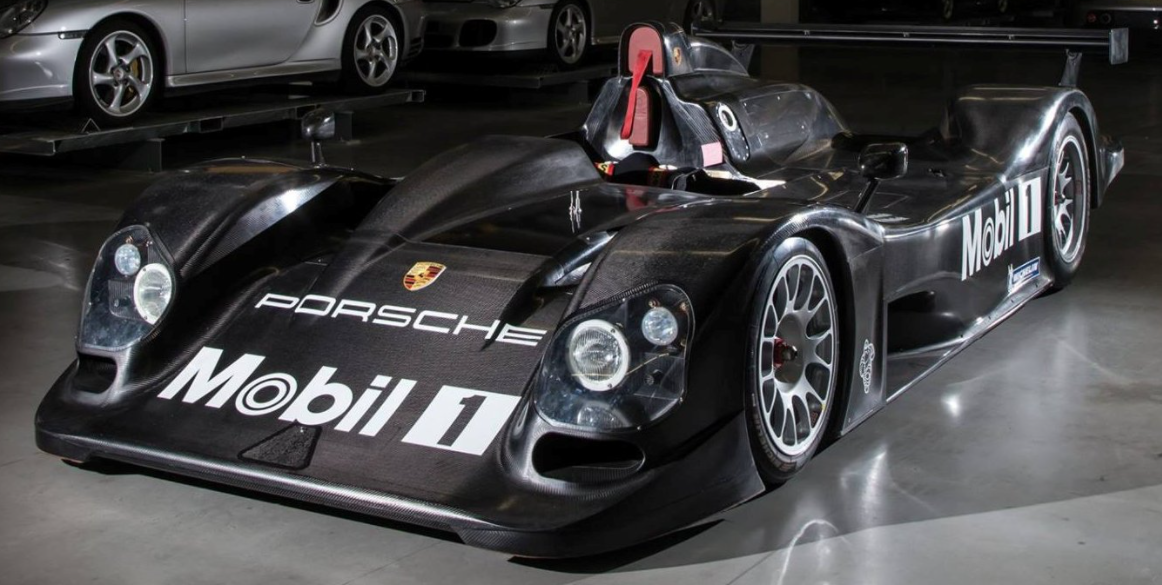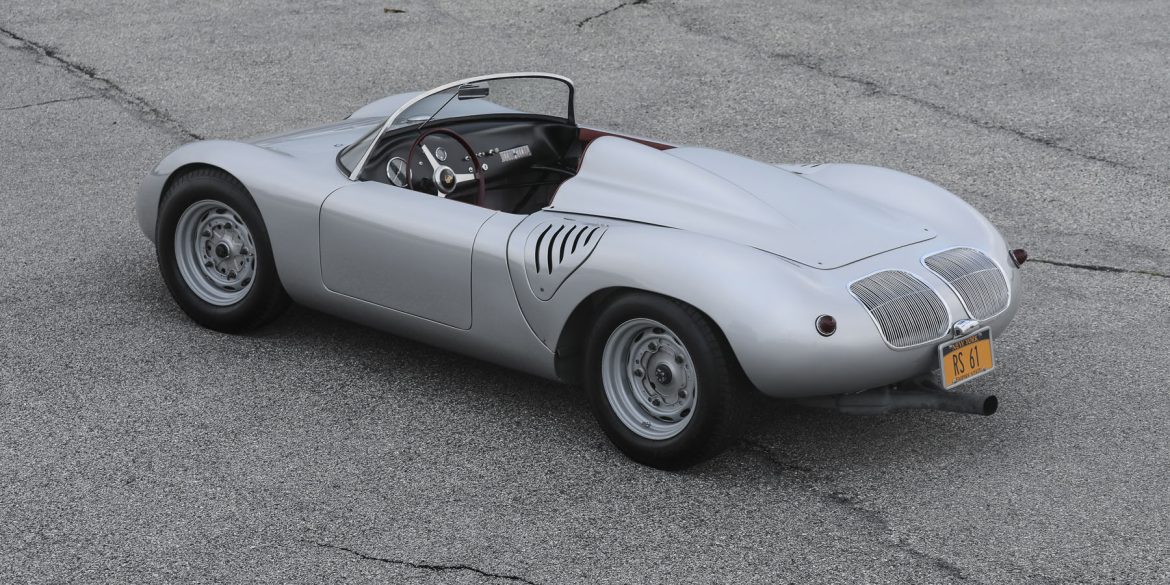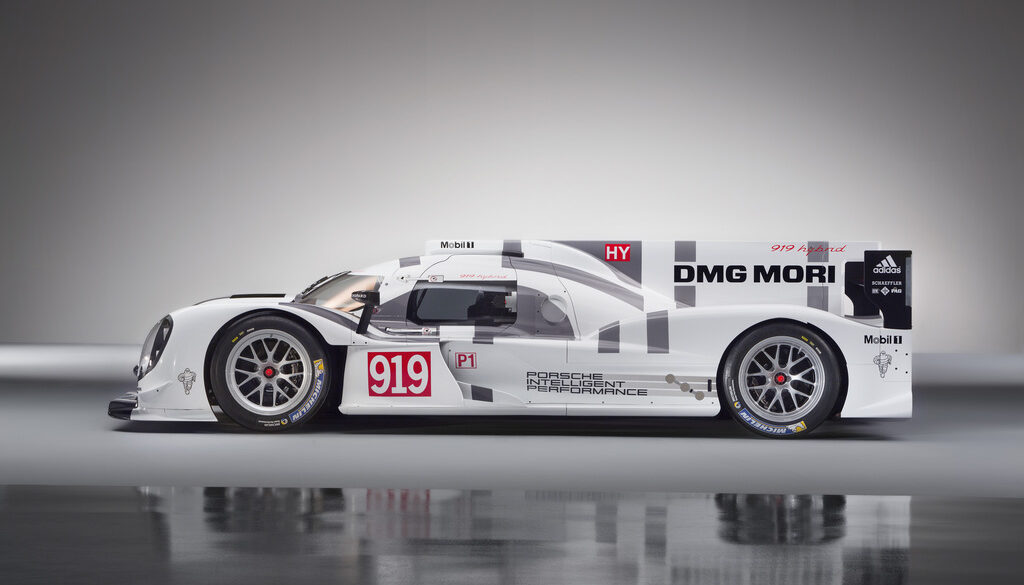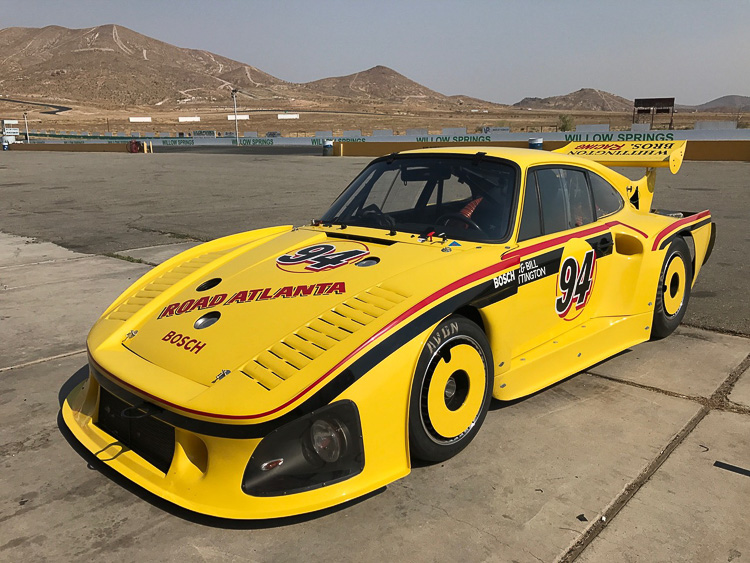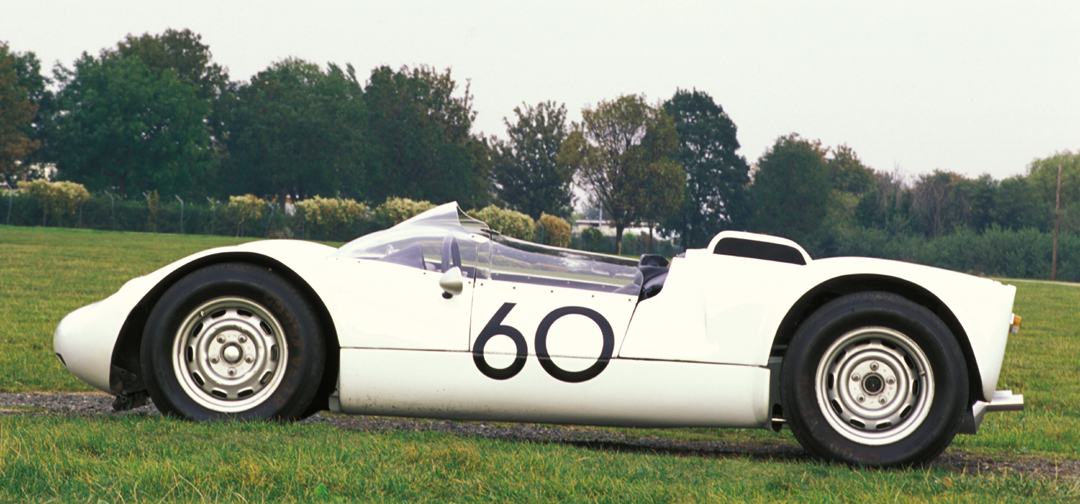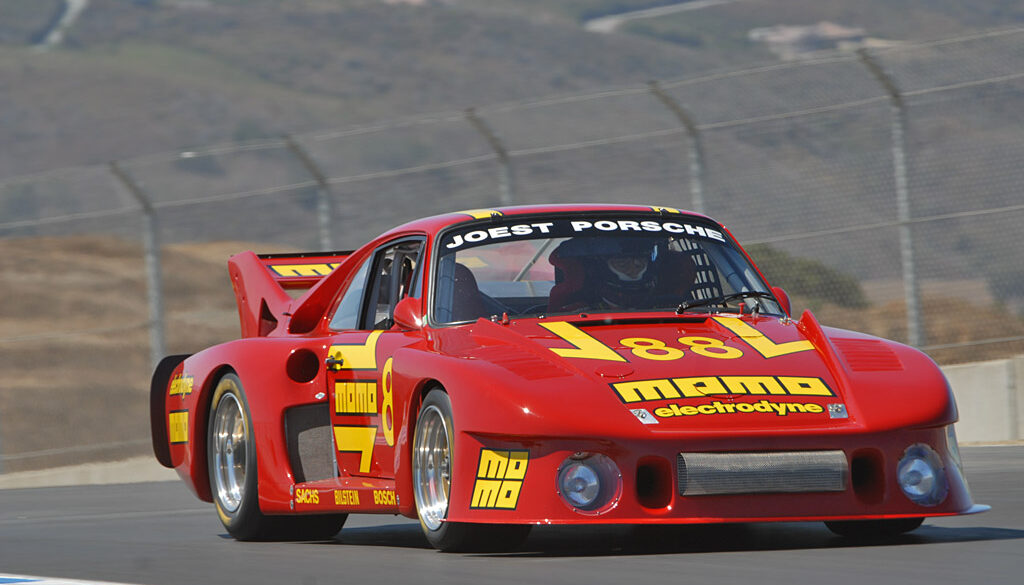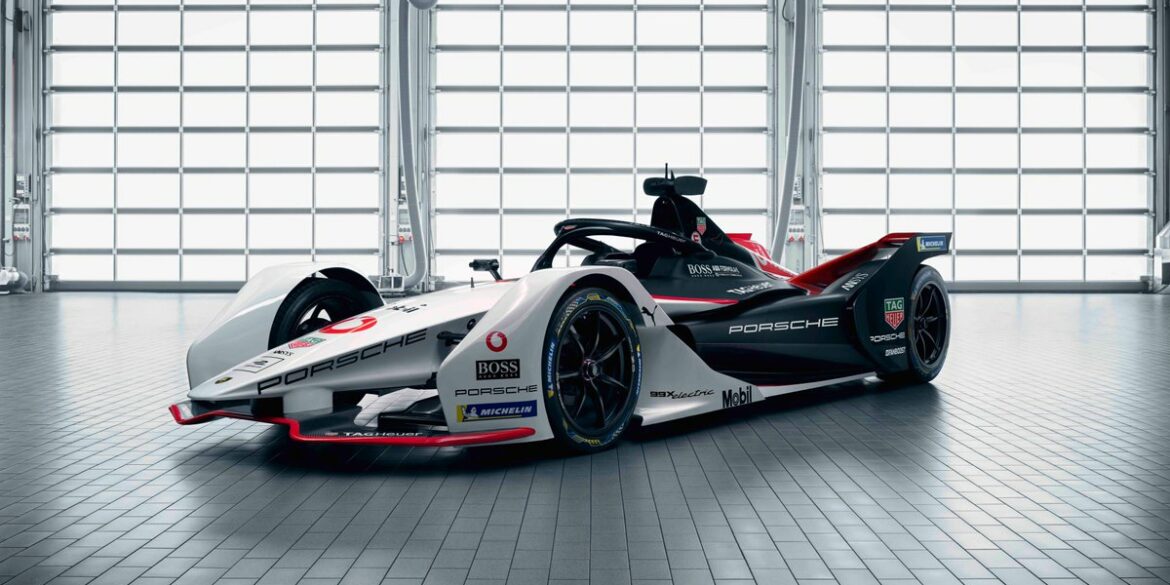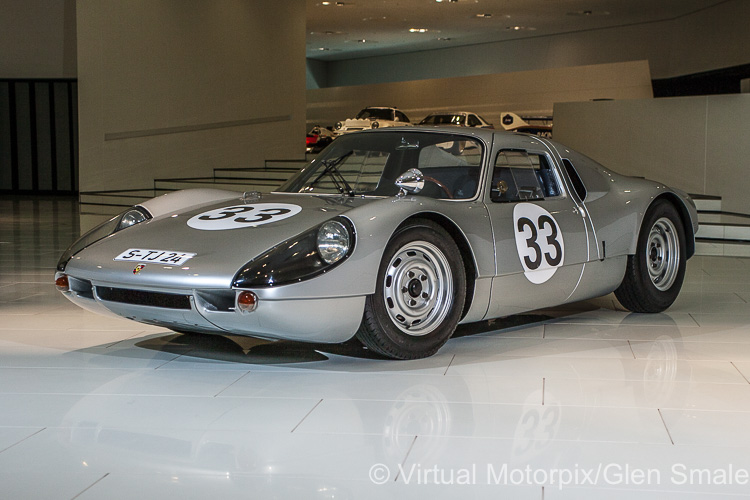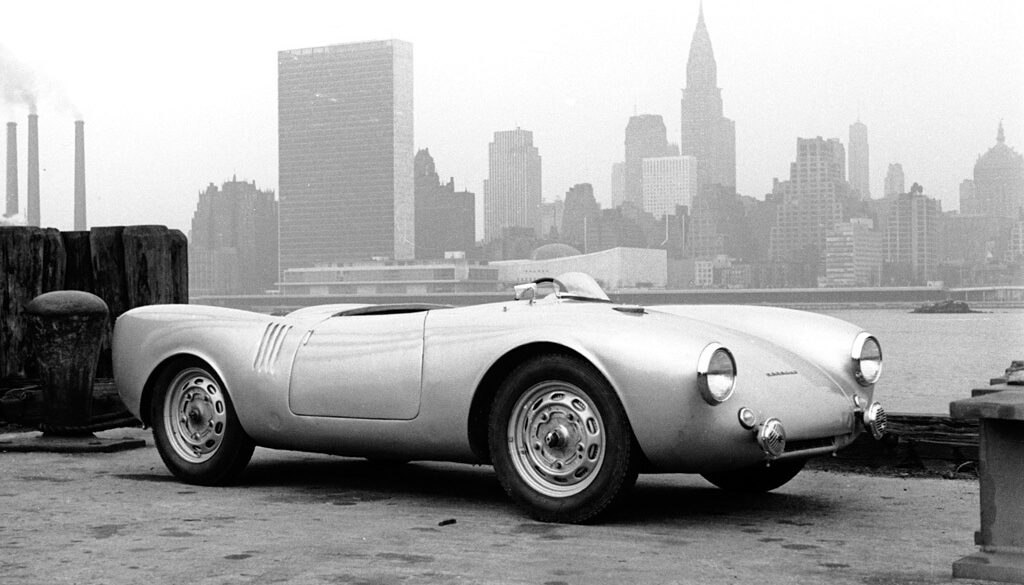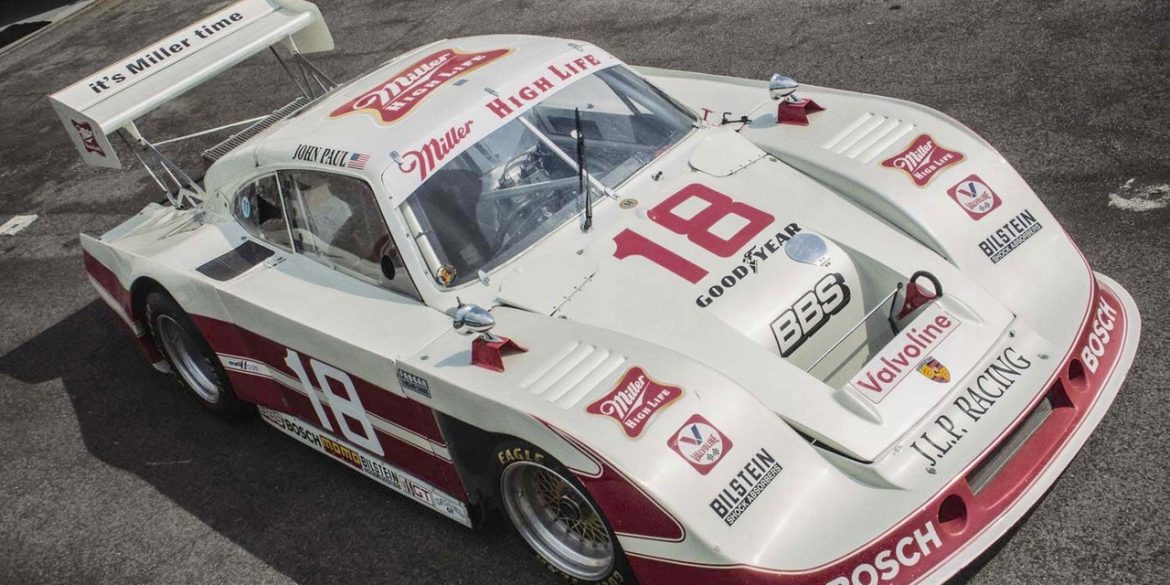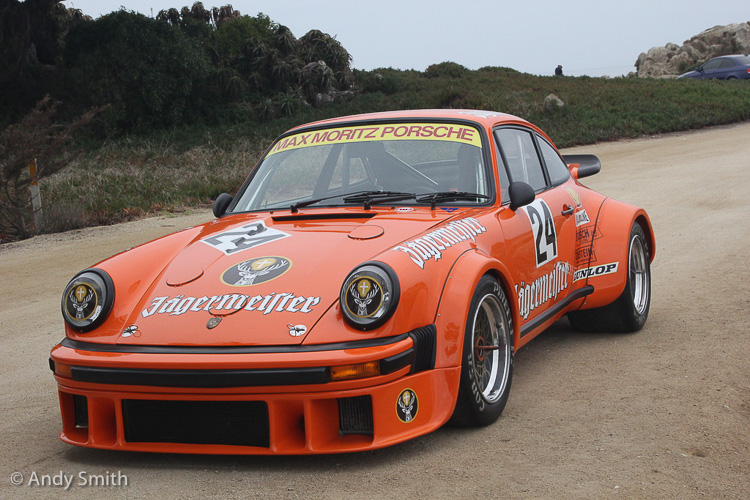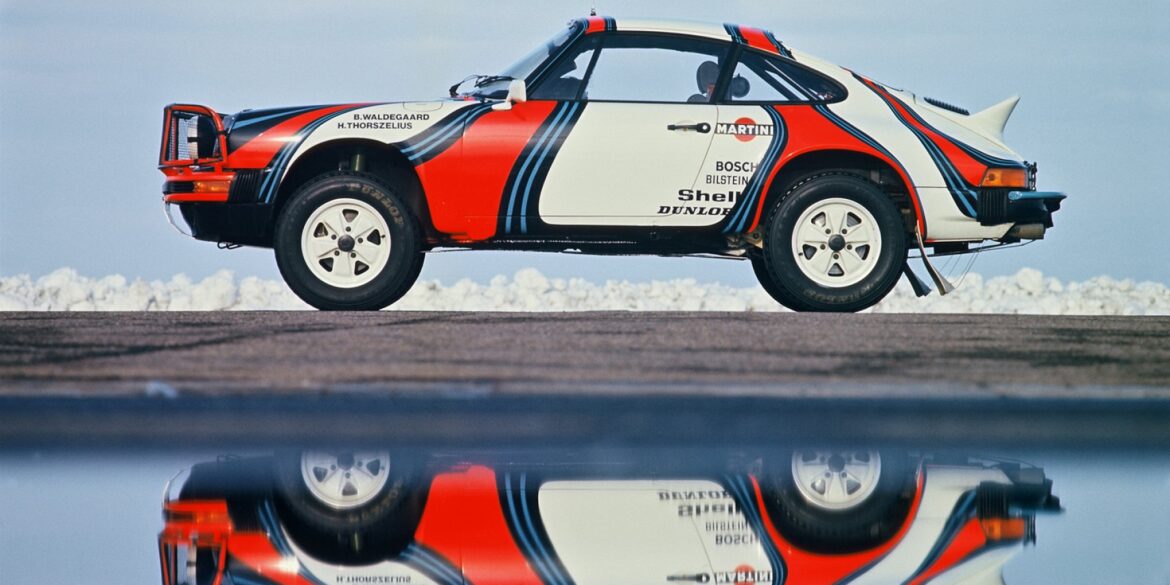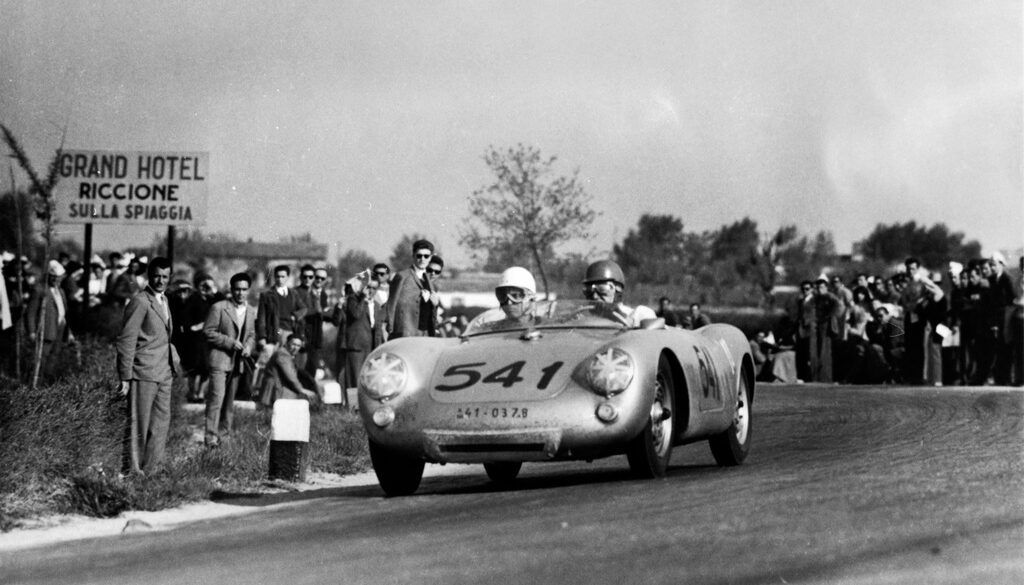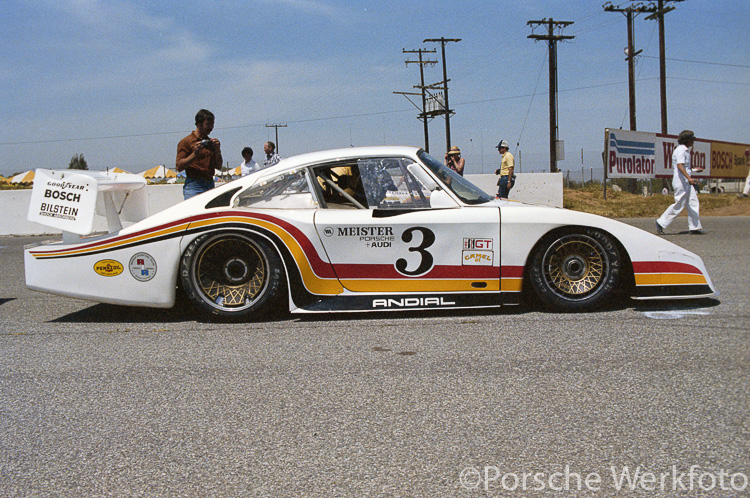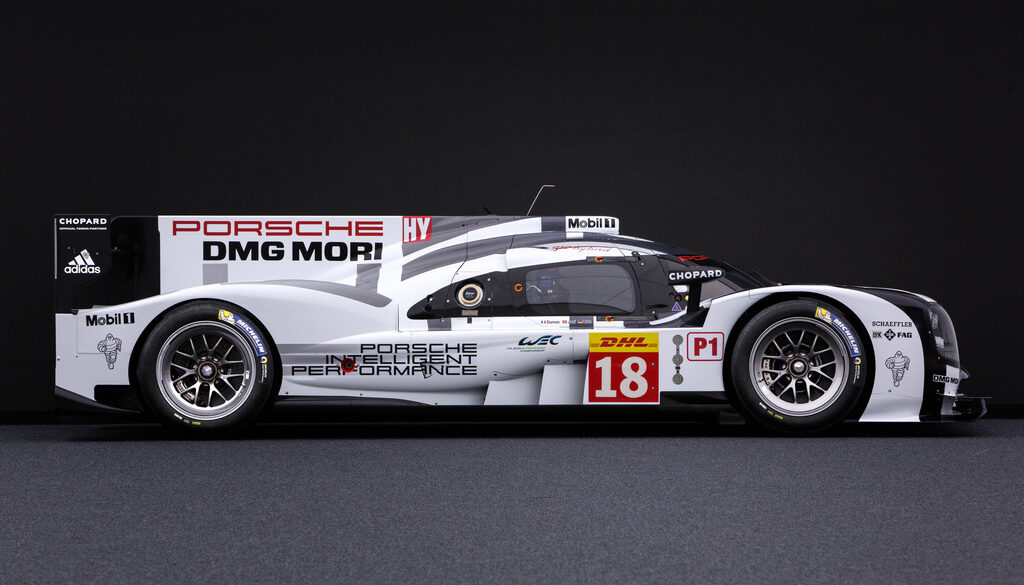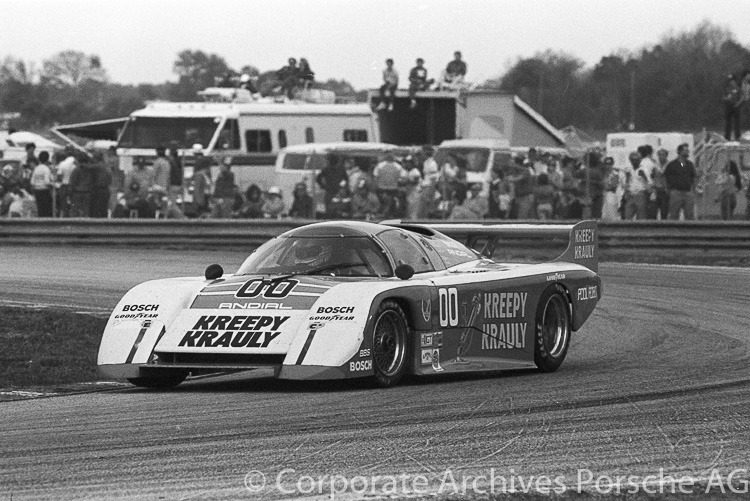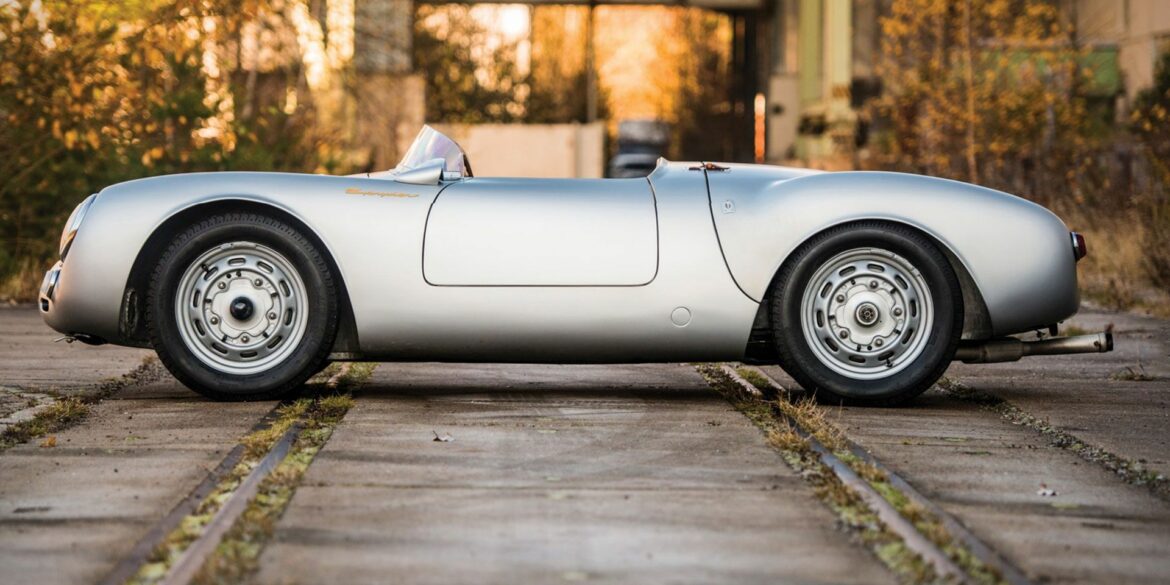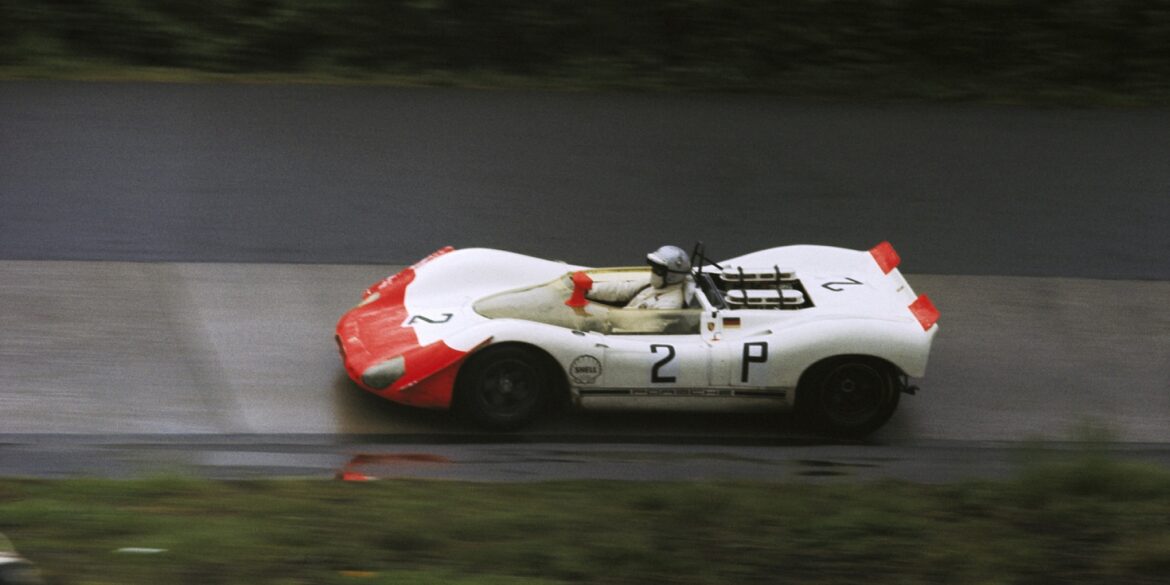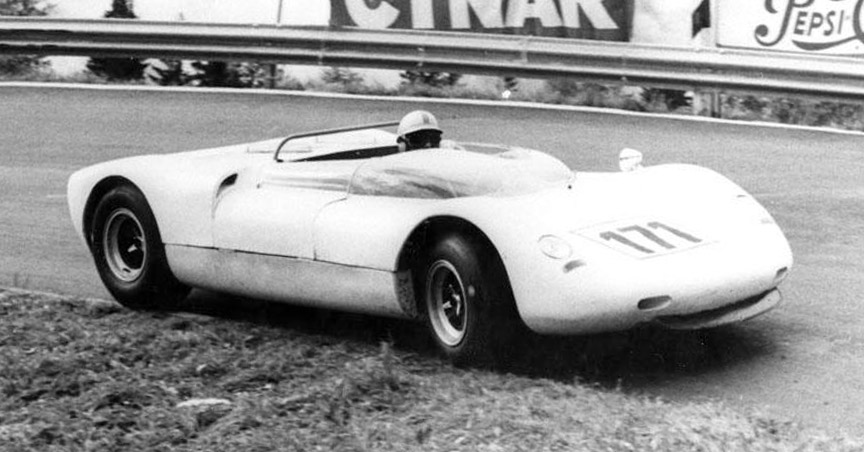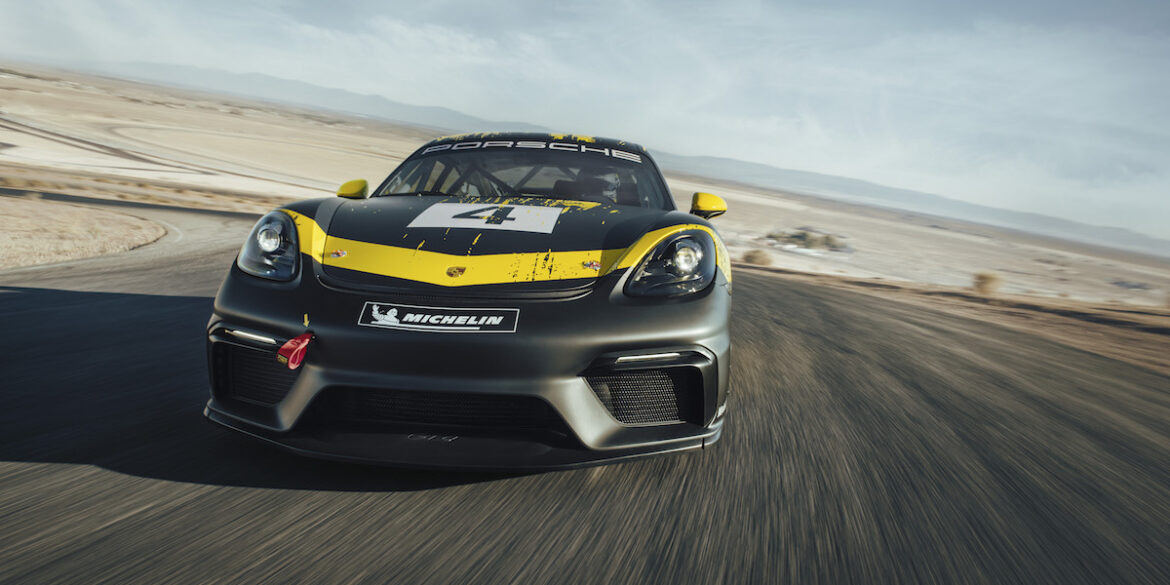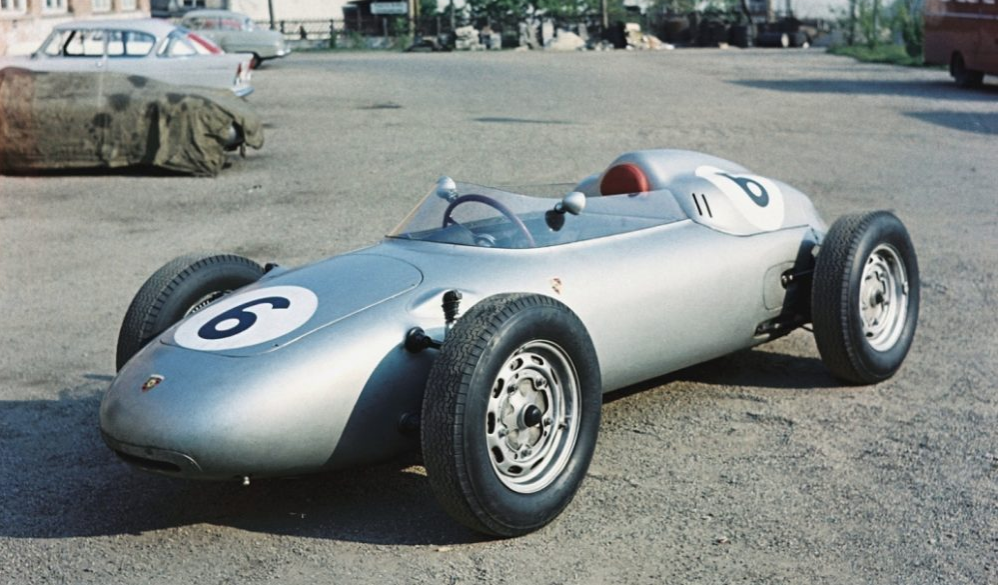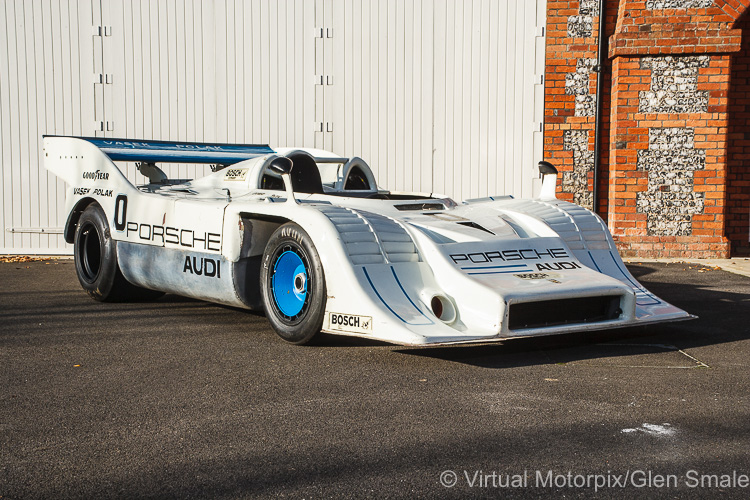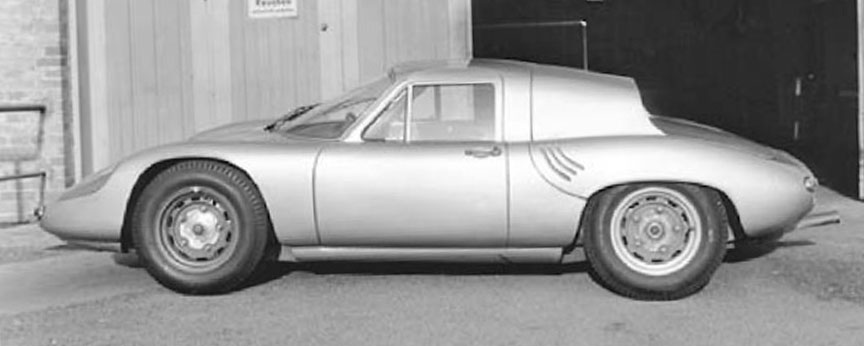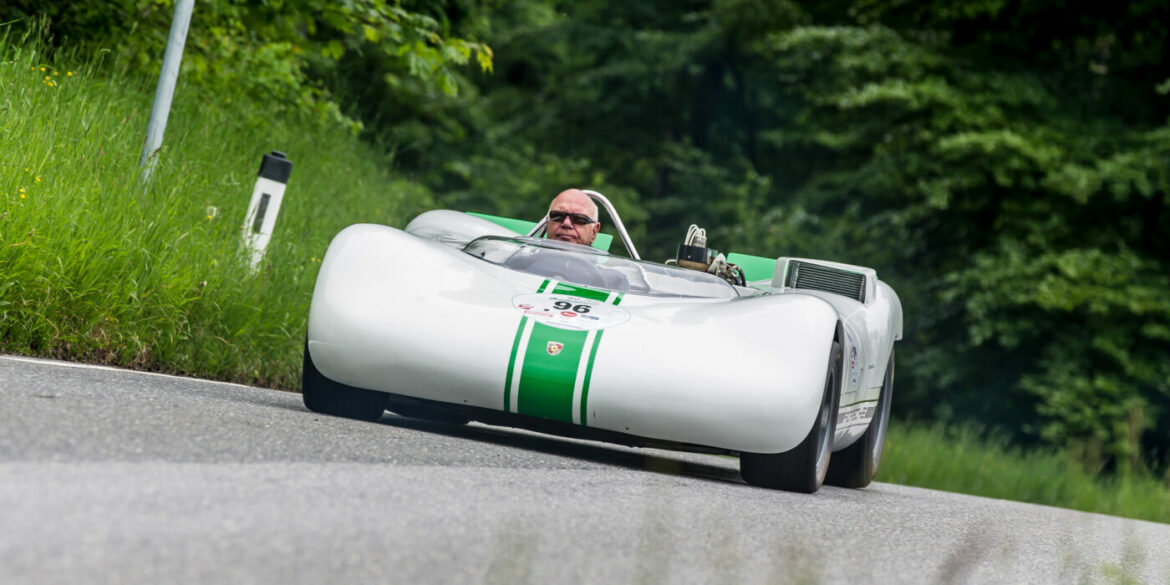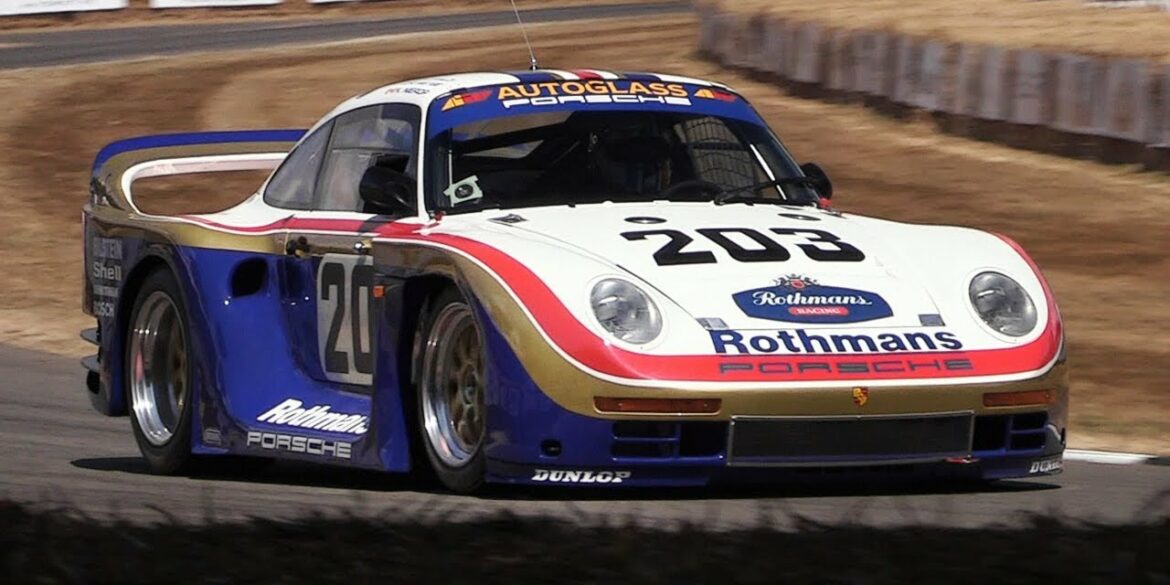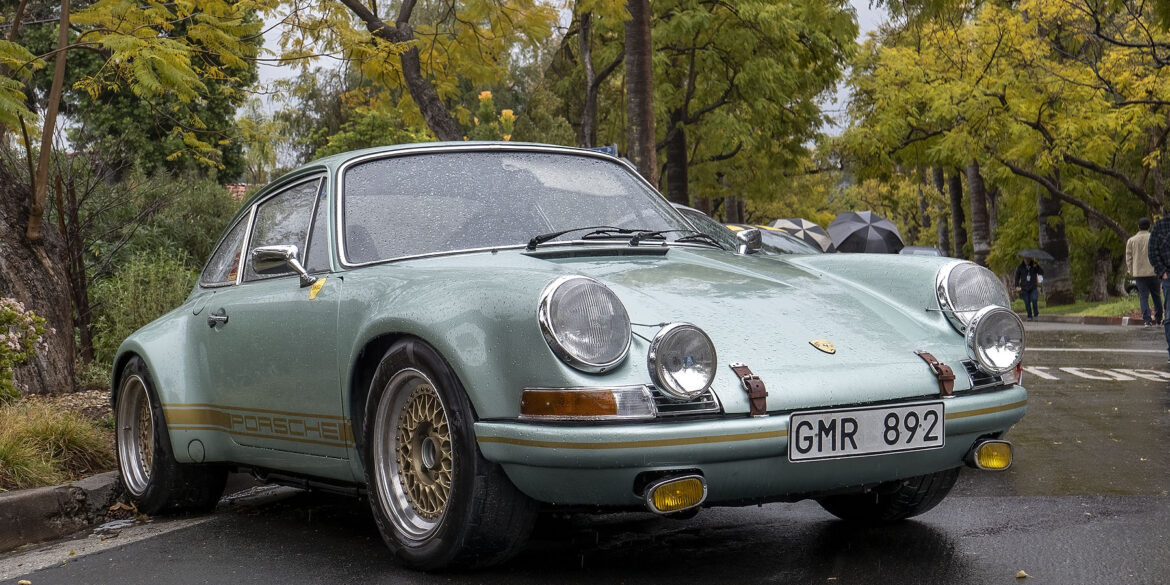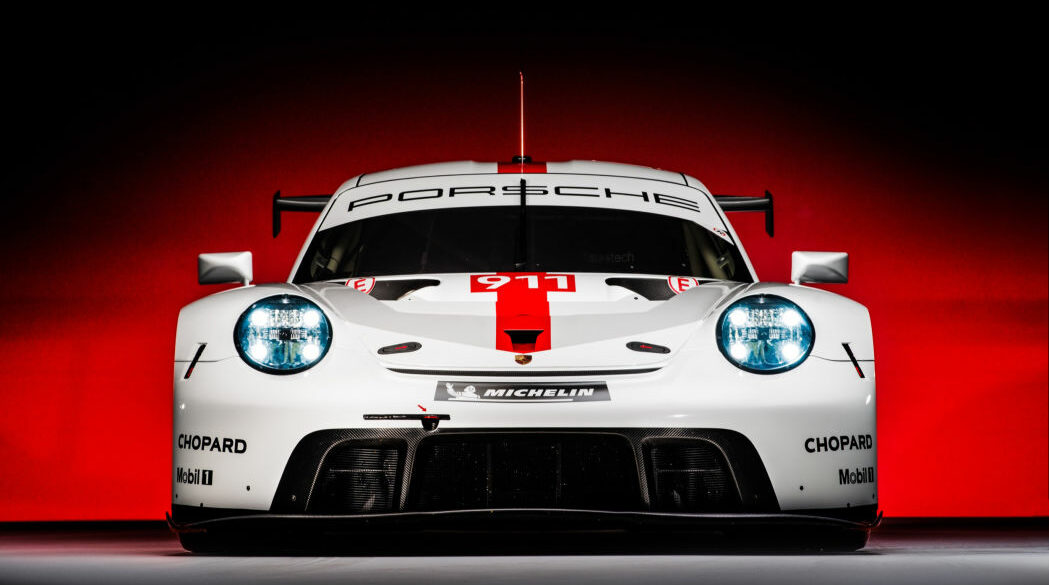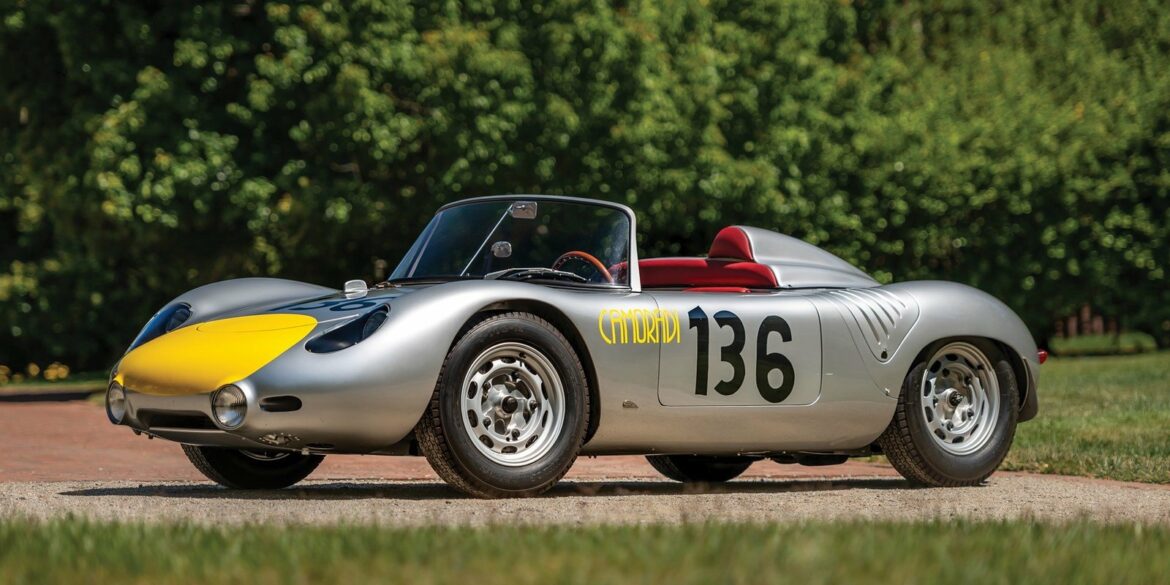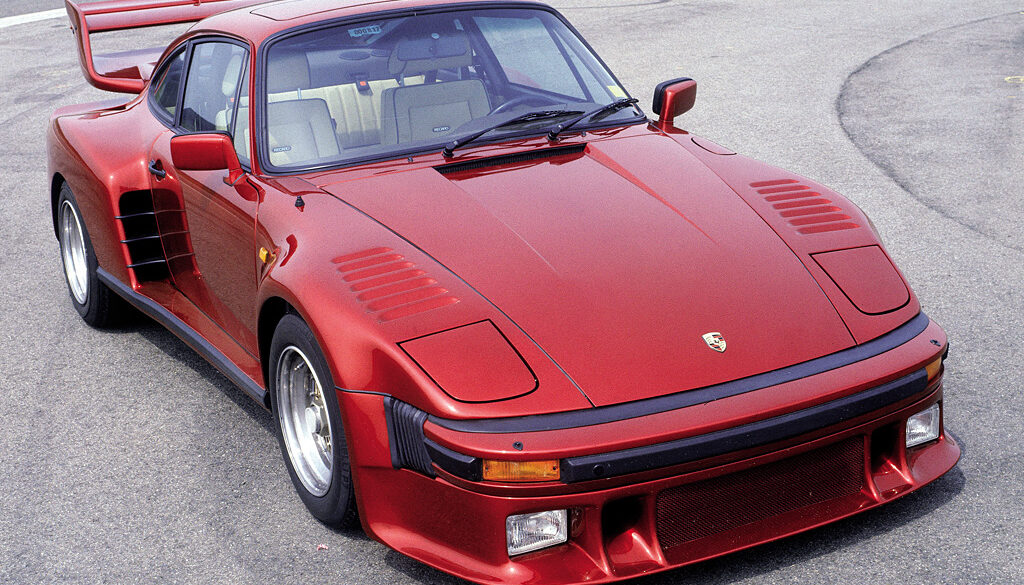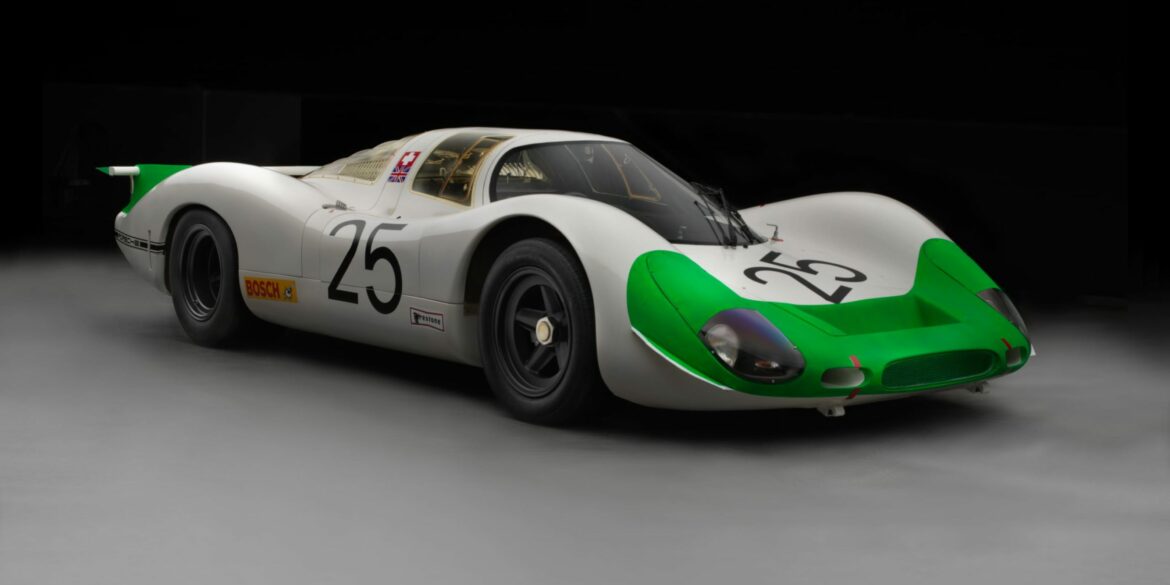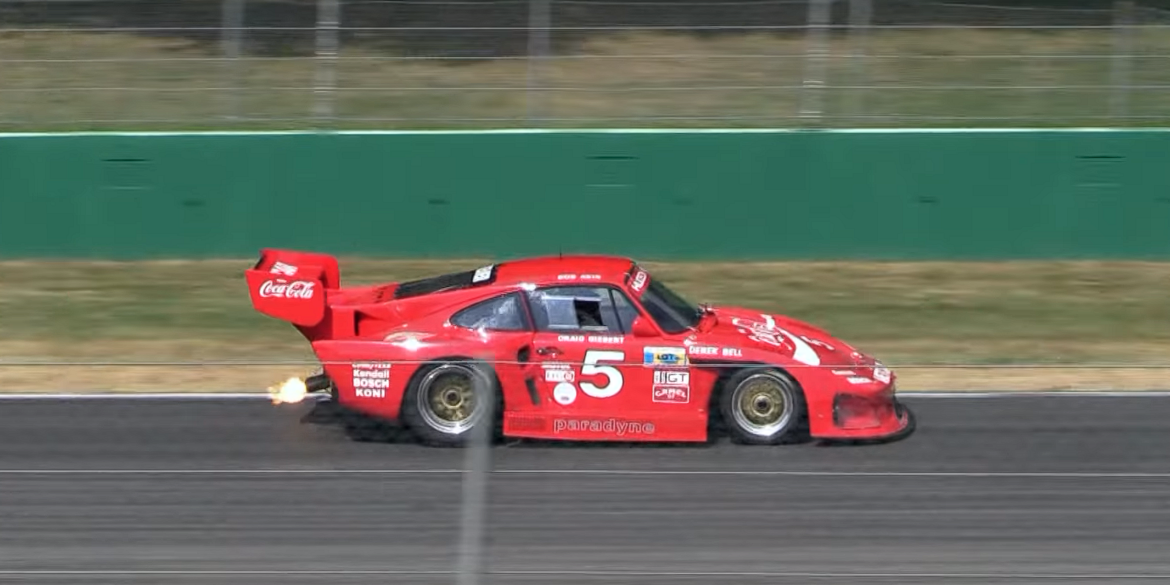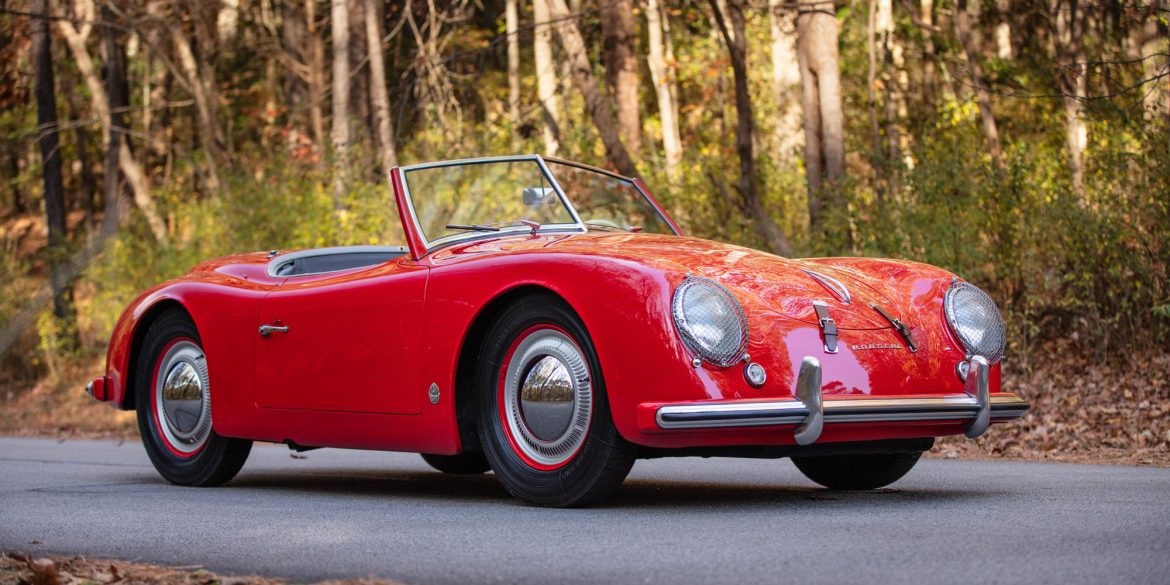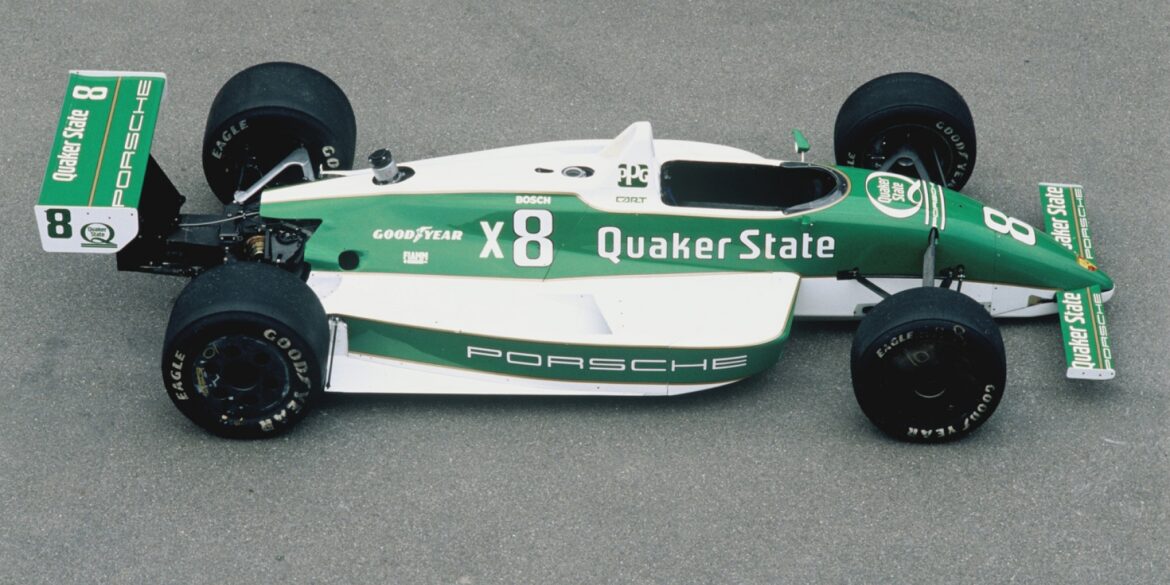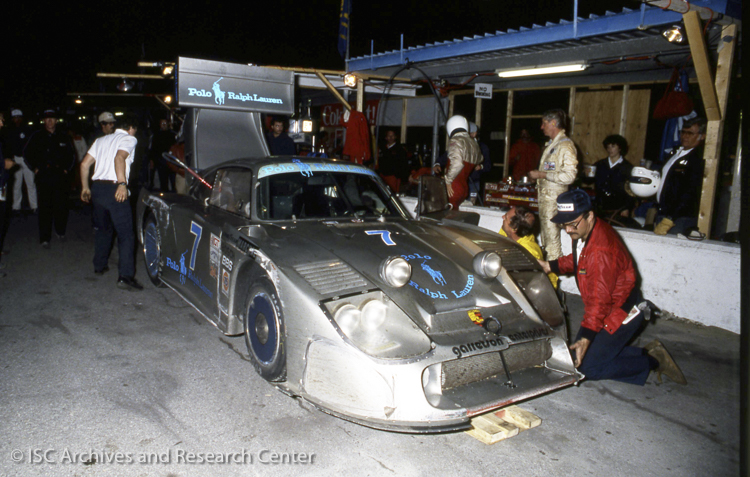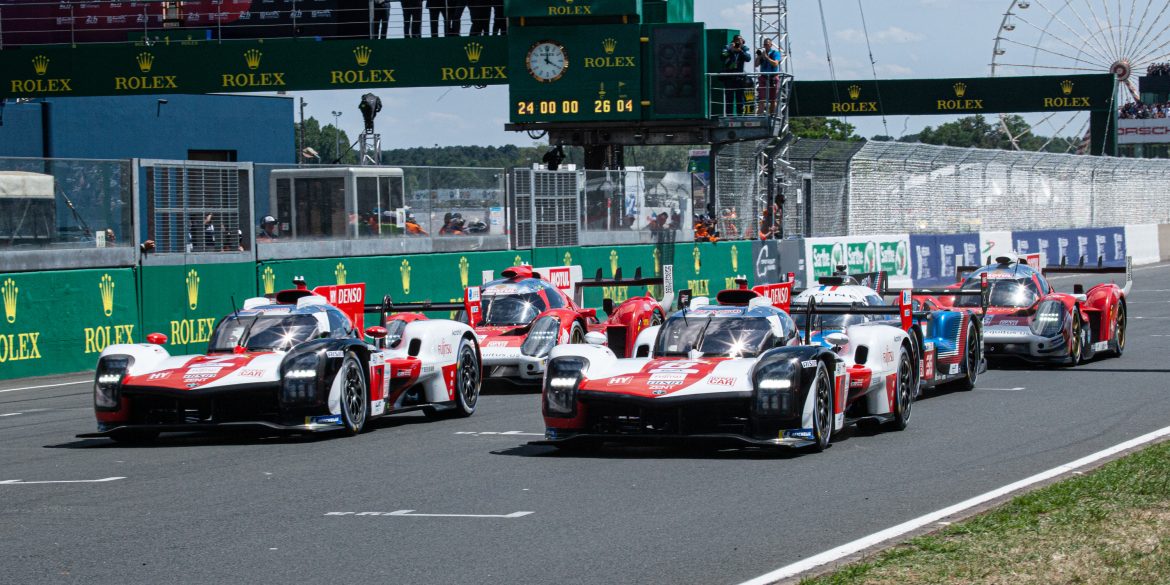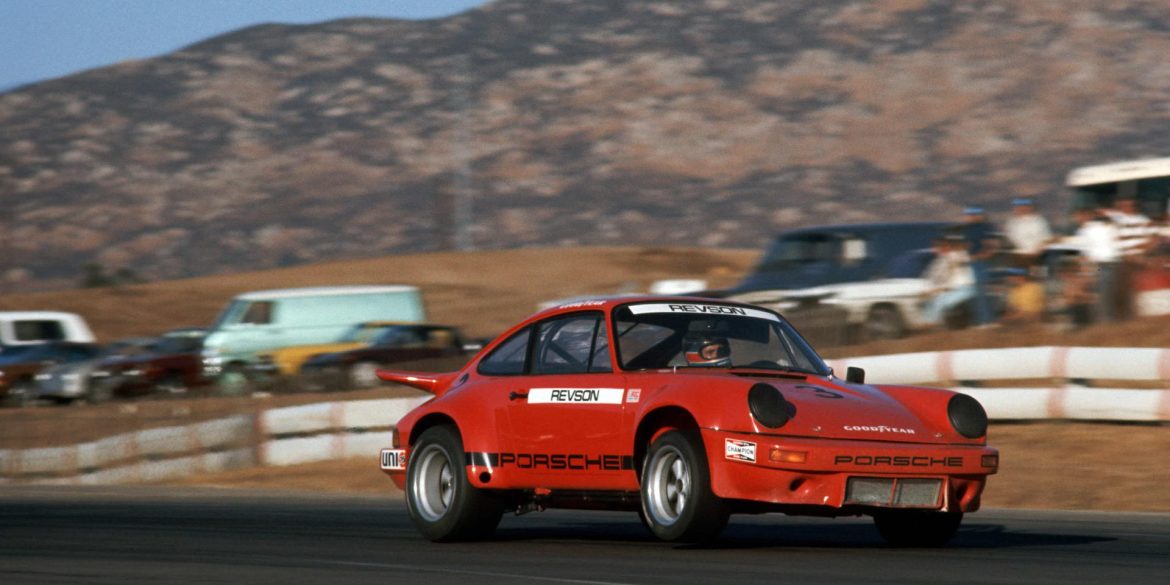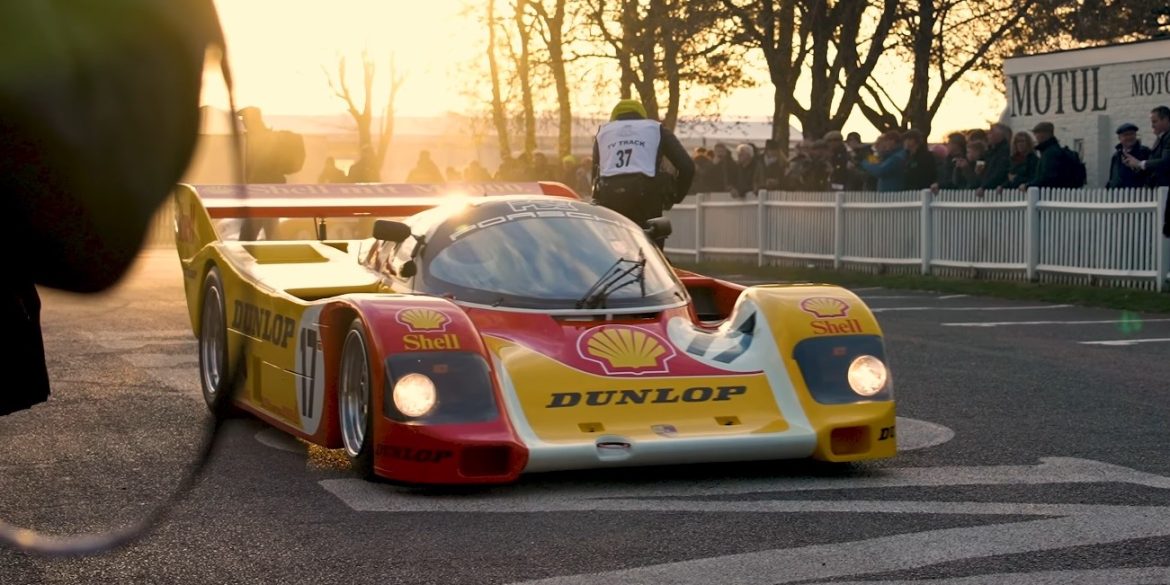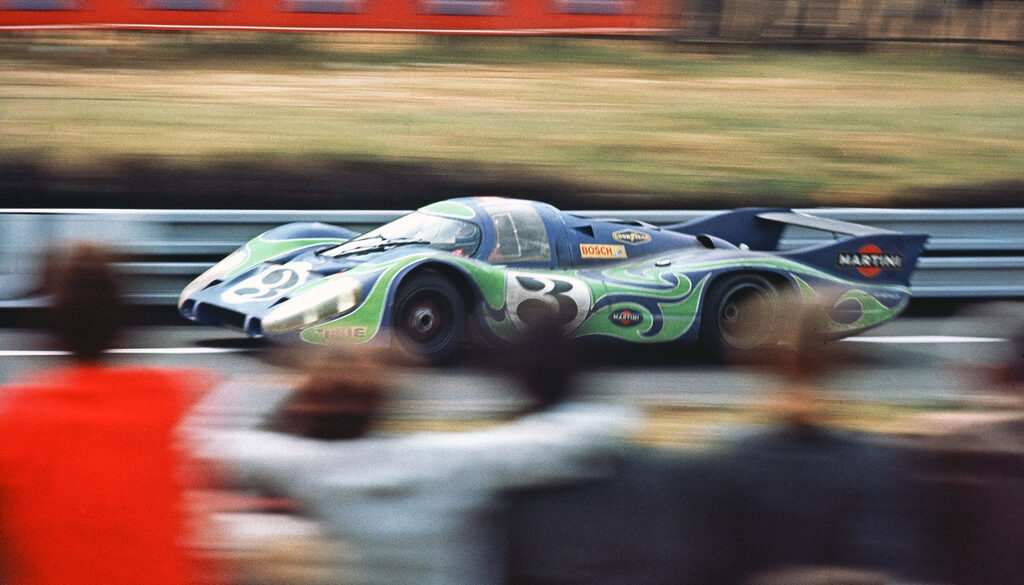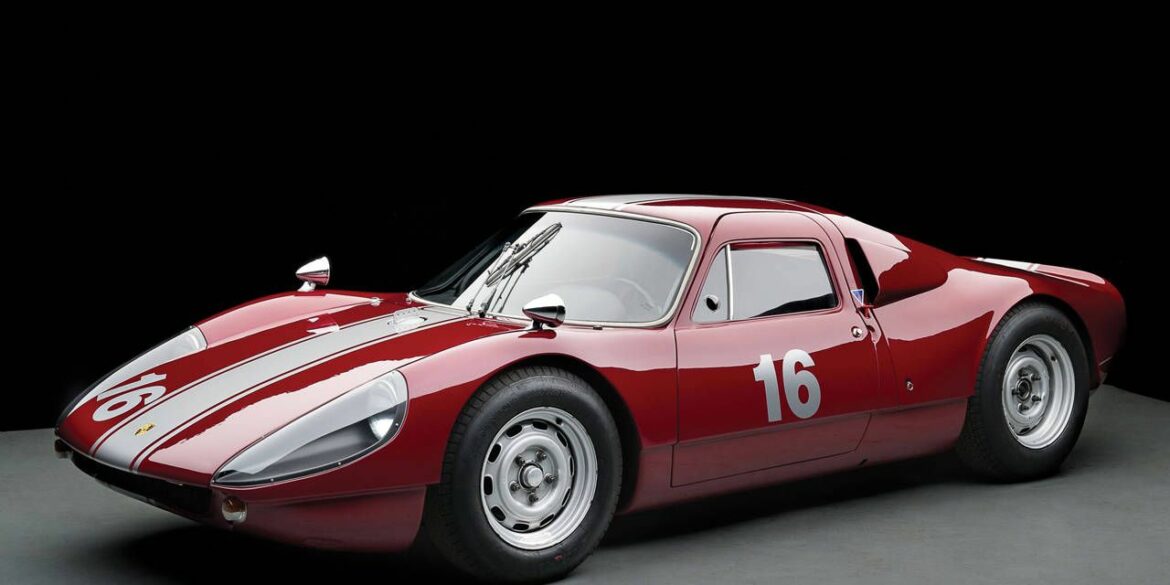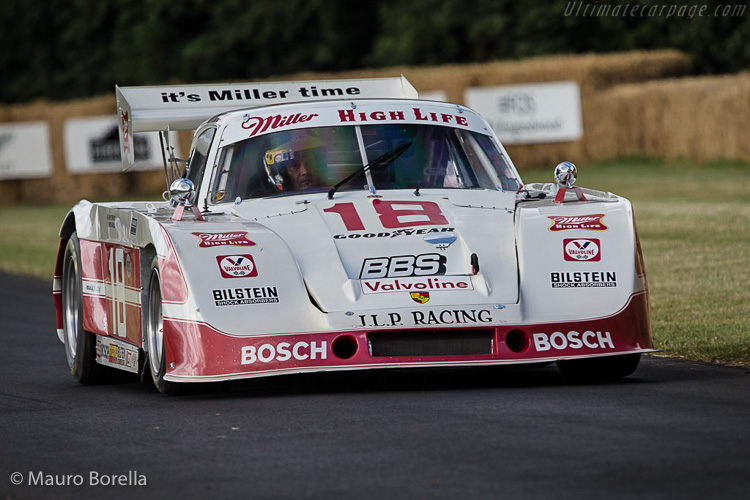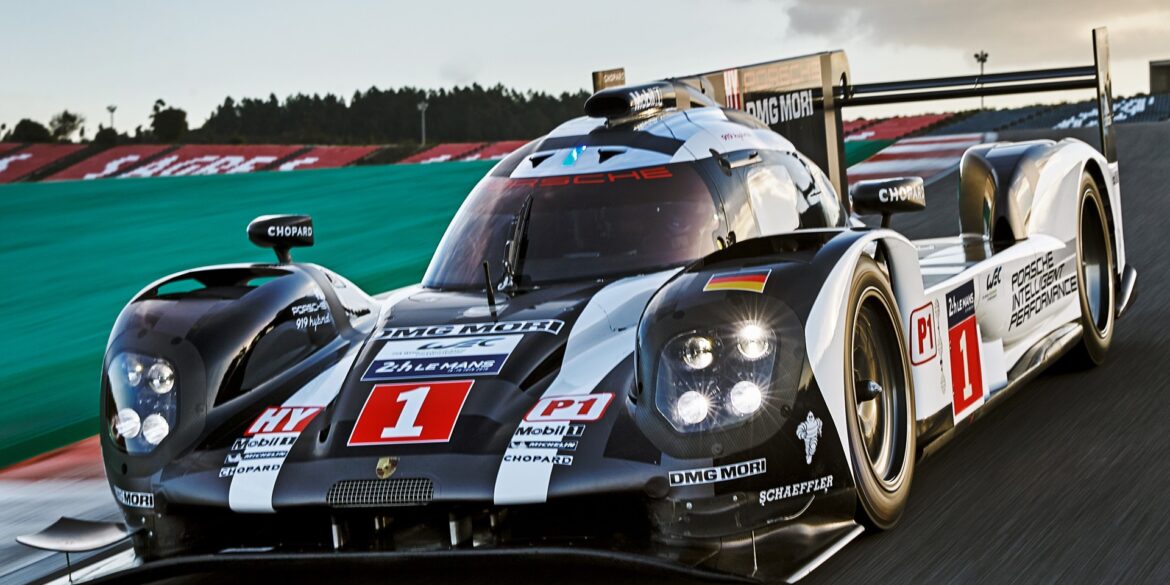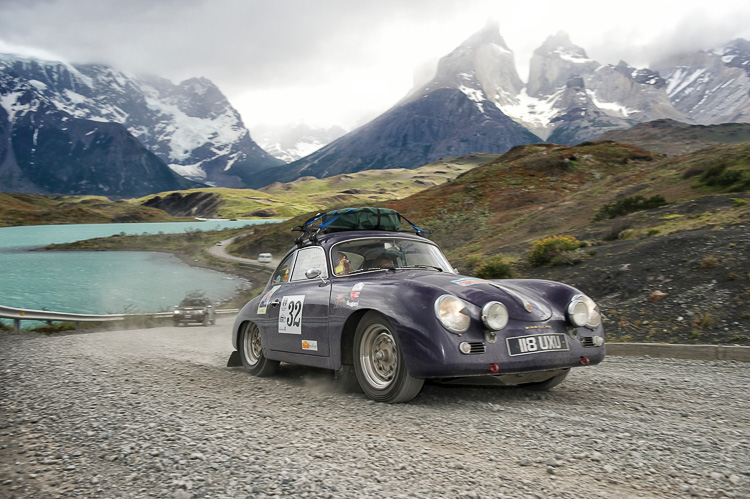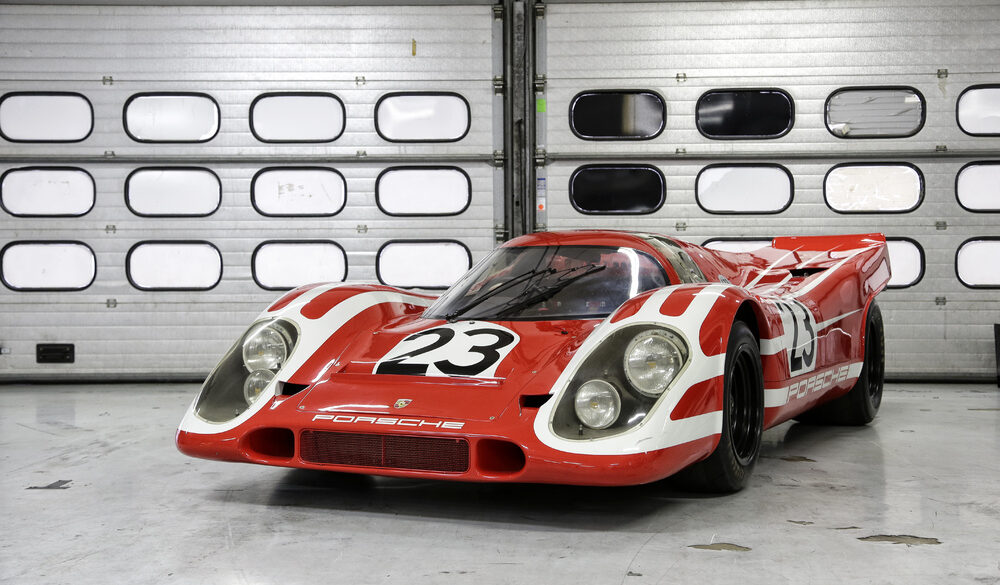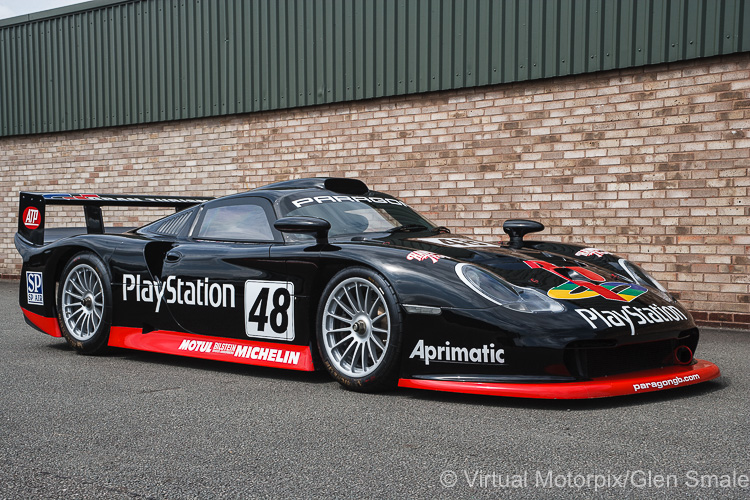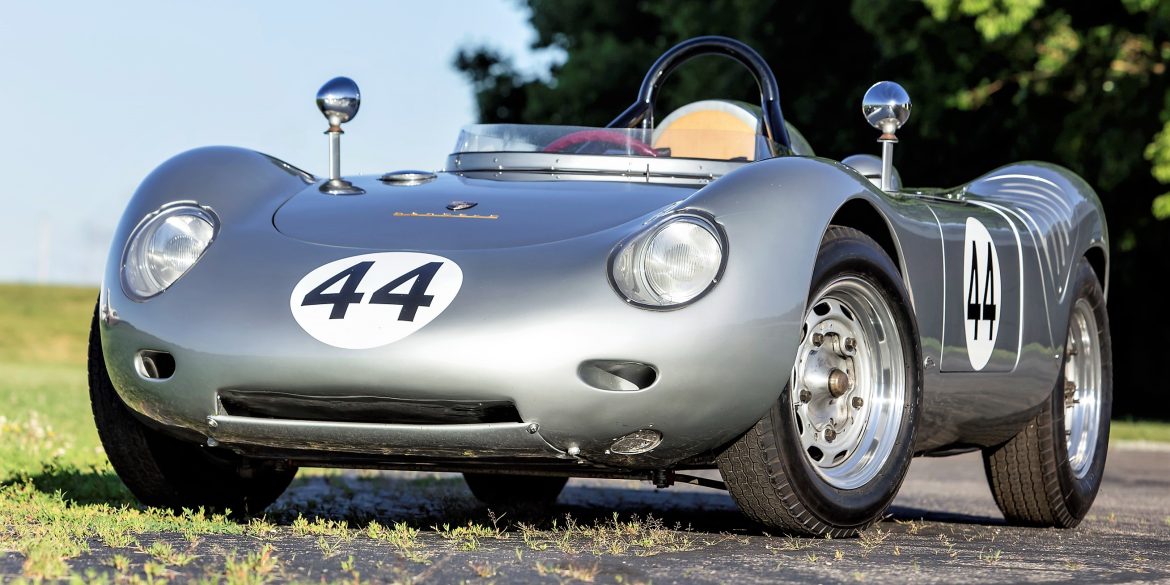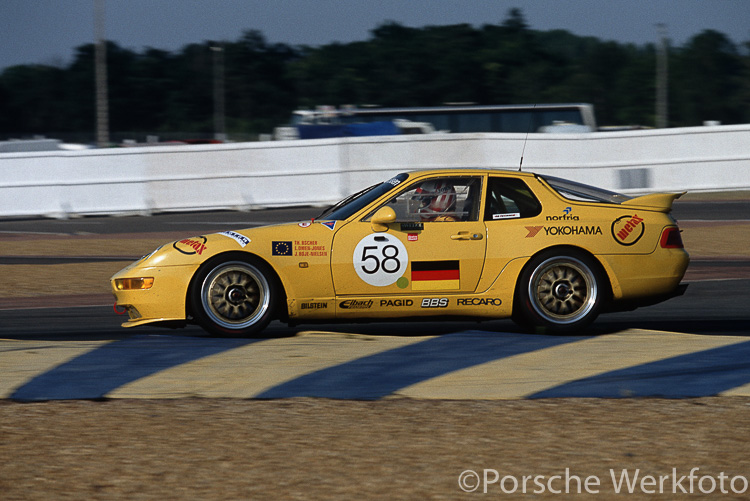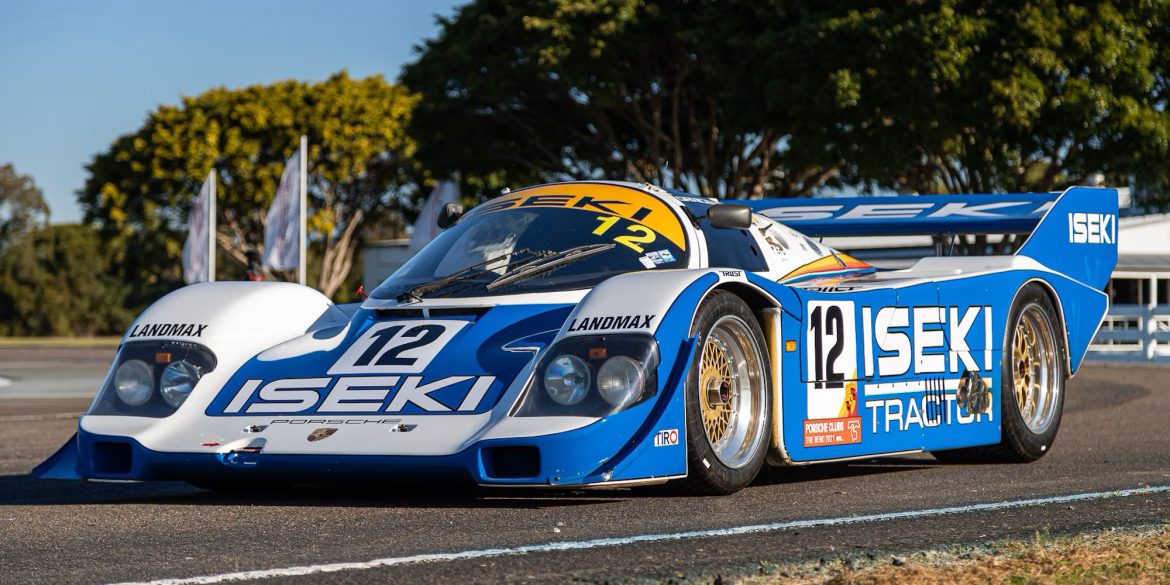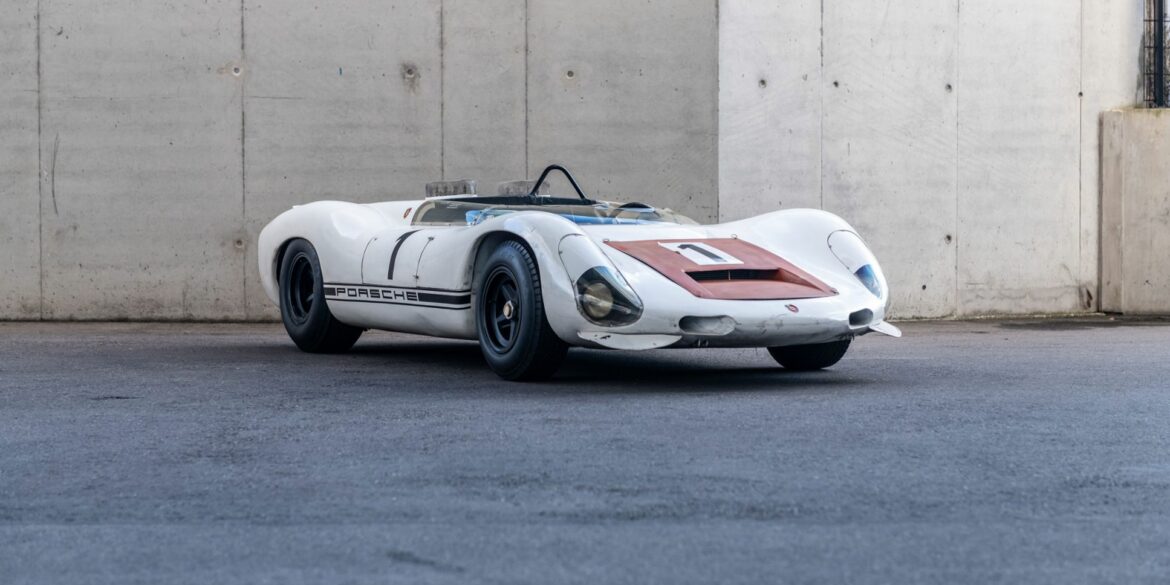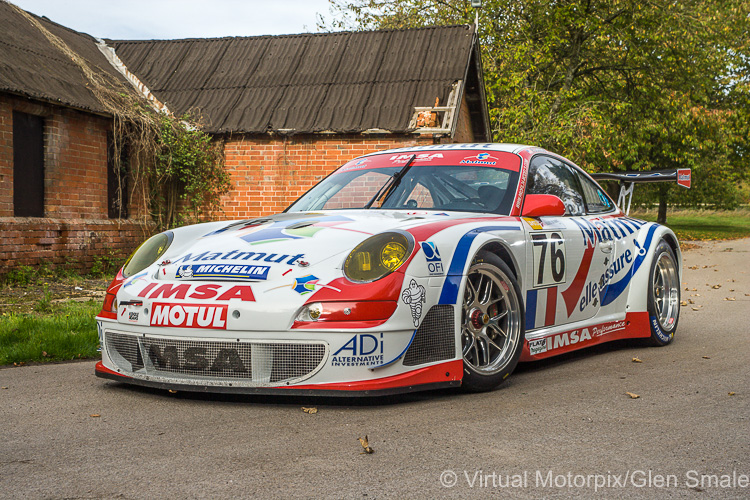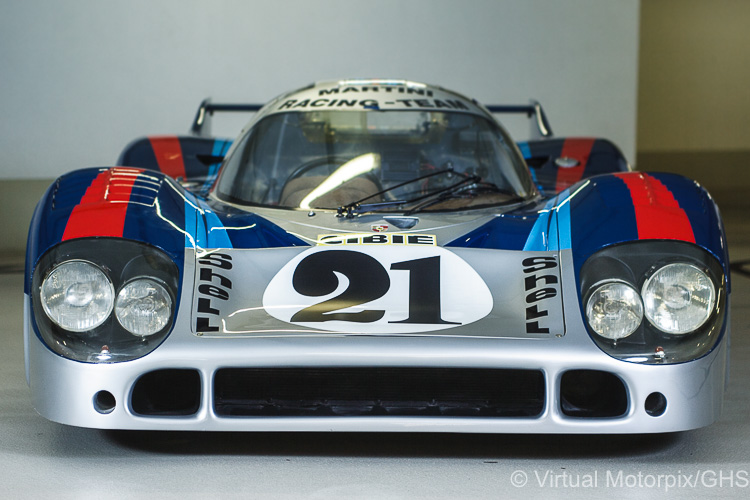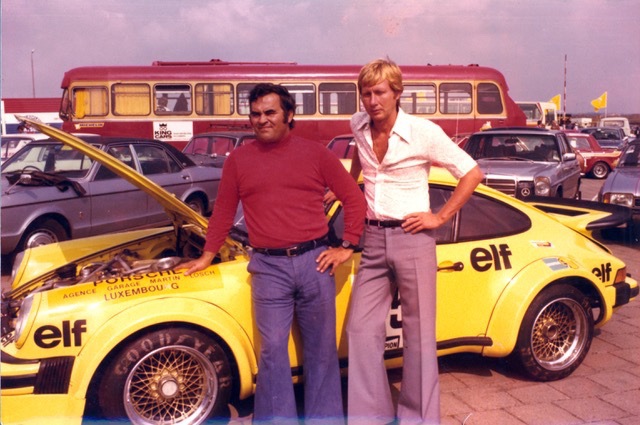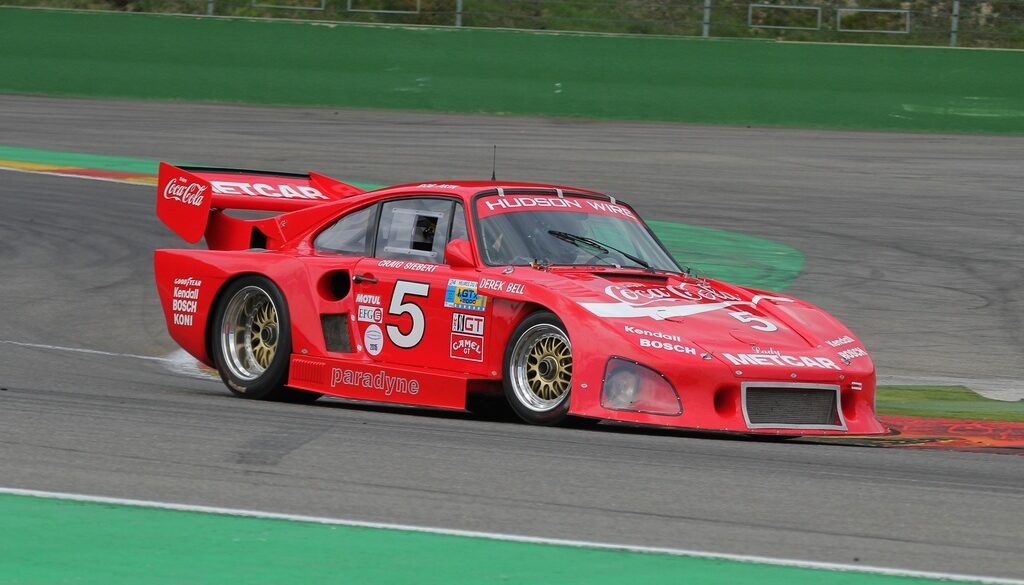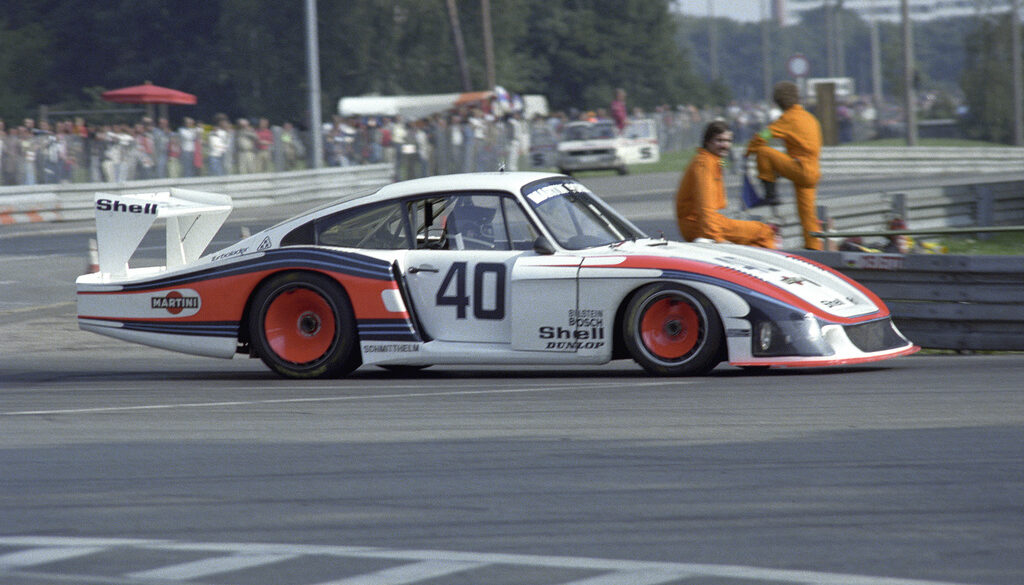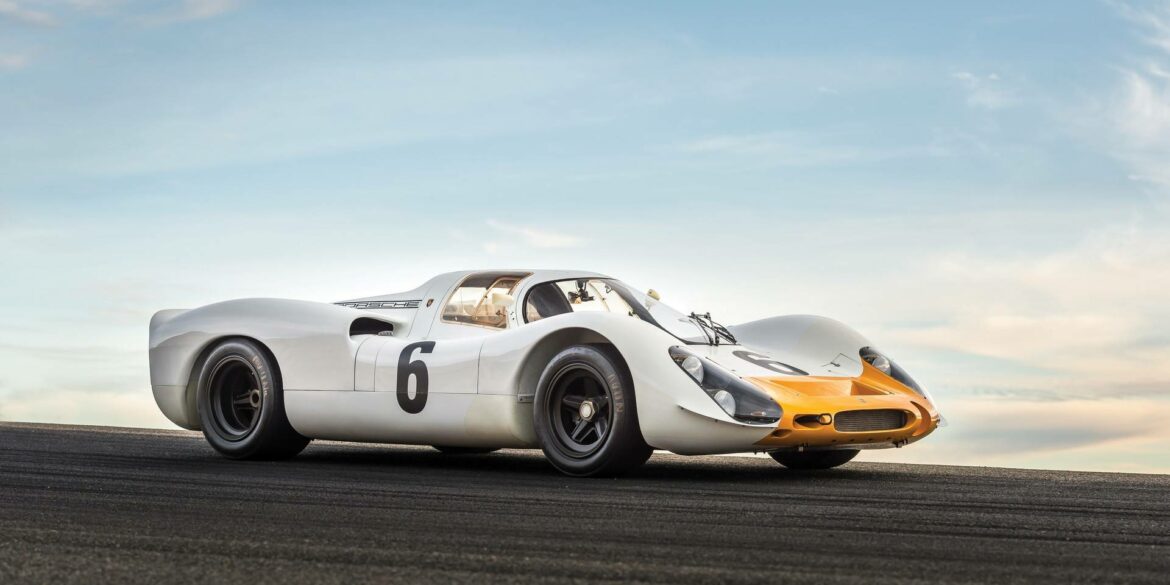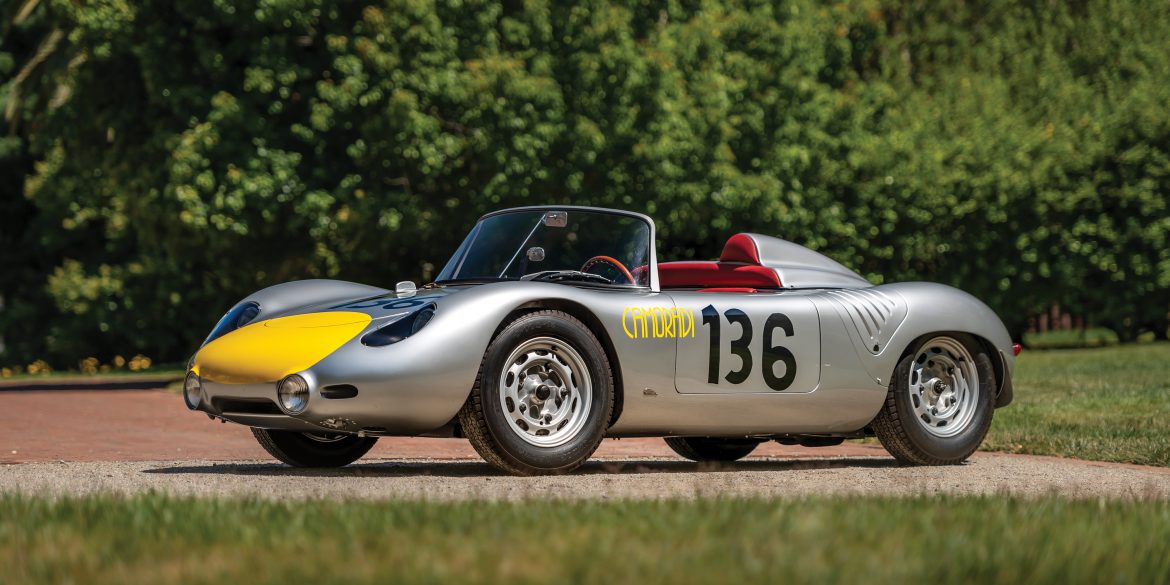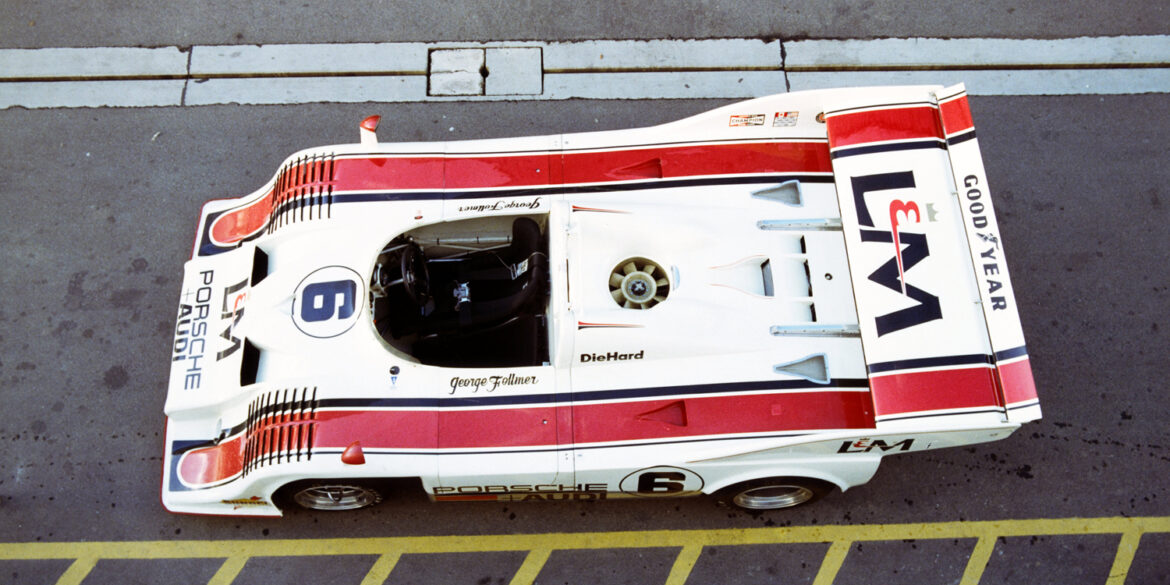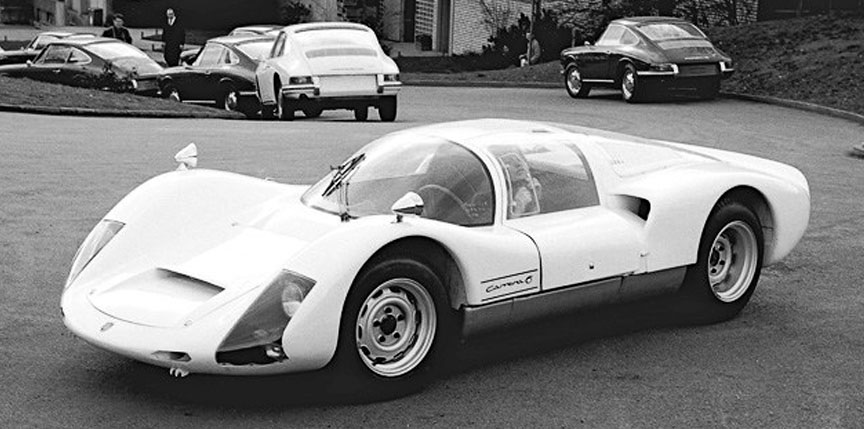The Group 6 Porsche 936 was the successor to the 908/03 and the turbocharged 917. While the 917 had a 5.4-litre flat-12 biturbo engine, the 936 got a 2.1-litre flat-6 single turbo engine. The reason for the 2.1-litre displacement was to fit inside the 3-litre class (turbocharged cars had a coefficient of 1.4). Despite the small capacity, the engine developed more than five hundred horsepower. Imagine such power in a ~700 kg/1540 lb car!
Porsche Race Cars
Jo Siffert was the first to take the 917 to Can-Am championship. The car he used in 1969, was the 917 PA Spyder. Although he participated in one Can-Am race in 1970 with a 917 K, that season he skipped. He was back from mid-season 1971 and now with the 917/10. Only two 917/10 were created in 1971. The chassis 001 was used for testing and the 002 by Siffert. He took part in six races out of ten, managed podium finishes three times and scored 4th in the season, like in 1969.
Le Mans 24 Hours, 9/10 June 1979: Its a tense time as the lead car, the #41 Numero Reserve Kremer Porsche 935 K3 driven by brothers Bill and Don Whittington, and Klaus Ludwig calls into the pits. Winning the Le Mans 24 Hour was without doubt the highlight of the...
The technology in racing during the mid 60s was shifting from carburetors to fuel injection. Porsche began experimenting and the Bosch injection system proved to be the most reliable. Though the performance did not increase, it did provide superior throttle response over the Weber carburetors, and it was easier to tune. To compliment the new engine, a new body was created which reduced drag levels. Porsche dubbed the resulting car, with its new engine and body work, the 906E, with the 'E' representing 'Einspritzung, or injection.
The silhouette is familiar. With weaves of carbon fiber covering almost every external surface, the Porsche 935/19 cuts an unmistakable shape. Like a black hole, it absorbs light and emits it judiciously. No chrome bits compete for attention. The car has presence. It has a sense of occasion. It is...
The Porsche 953 ranks as one of the finest off-roaders Porsche has ever made. It was basically a souped-up 911 designed specially to give Porsche an advantage in the 1984 Paris–Dakar Rally. Just a year later, it was replaced by the 959. Despite its brief run, it still managed to make quite the impression. Built around a massively enhanced suspension and a supremely powerful 300 bhp (224 kW), 6-cylinder engine, it showed Porsche knew more than just sportscars.
D.E. ( Driver Education) It’s a gateway drug. You are happily driving your Miata, Mustang, or Cayman on the street; you’re enjoying yourself, not a care in the world. Whether it’s peer pressure or a chance meeting, someone gets you hooked on the hard stuff. You head off to a...
Although the longtail 917 was introduced first, it was meant only for the Le Mans. This meant, the short tail 917 K ("Kurz" in German for short) was raced first. The only engine available in 1969 was the 4.5-litre flat 12. The factory team enters one 917 K also for the Nürburgring 1000 km race, where it scores 8th. The factory team would not enter 917 K for racing anymore in the season, only private teams will.
The Porsche 961 was the racing version of the 959 supercar. While the 959 rallye car was also internally called 961, publicly only the circuit racer was called 961. Only one 961 was built. It had 959 prototype chassis number which in turn was from the 1985 911 Turbo chassis number sequence: WP0ZZZ93ZFS010016. The 961 was entered at the 1986 Le Mans 24 hour race. Uncommonly, the 24 hour race was scheduled for May 31-June 1 that year, two weeks earlier of the typical Le Mans weekend in the middle of June.
The Cisitalia Grand Prix is a single-seater car for the postwar 1.5-litre supercharged Grand Prix class, built by Italian sports car manufacturer Cisitalia and introduced in 1949. It was designed on behalf of Cisitalia by Porsche between 1946–47, and is therefore also known by its Porsche project number, Typ 360. An extremely advanced design, it proved too complex to build for the small Italian firm (and lead to the financial downfall of the company).
Porsche’s Type 904 was officially called the Carrera GTS because Porsche and Peugeot were still in their bitter disagreement over numeric designations with “0” in them. The Porsche 904 succeeded the RSK Type 718 as the last sports-racing iteration of the 356 series. It was also the last full-competition Porsche...
Lined up in the pit lane before the 1994 Le Mans 24-Hours, is from the left: #36 962 Dauer Le Mans GT driven by Mauri Baldi, Yannick Dalmas and Hurley Haywood; centre is the street-legal 962 Dauer with rather appropriate Boeblingen region (Weissach) registration plate ‘P 962’; on the right...
You just picked up a nice sports car—like a Porsche 718 or Porsche 911—to bomb around town in. Your gearhead friends egg you on to take it for some laps around the local circuit in order to experience what your new ride is truly capable of. The prospect of doing...
In 1967 and 1968, the Porsche 910/8 Bergspyder was the dominant force before the 909 came along. Porsche’s 910 was essentially an updated 906 and were championship-winning machines thanks to being extremely nimble and well-suited to mountain roads. It had titanium (brake calipers), beryllium (brake discs), magnesium (wheels), electron (tank), plastic (body) and aluminium. The running gear was similar to that of a Formula 1 car, including an eight-cylinder boxer engine.
Porsche 910 was the evolution of the 906 with Ferdinand Piëch as its main driving force and Hans Mezger as the head engineer. It came before 907, 908 and 909. Compared to the 906, the 910 had 13" Formula 1 wheels with central locking (906 had 15" 5-bolt wheels), more rounded design everywhere and the roof panel was removable. Because of the targa roof, the cool-looking gullwing doors of the 906 had to be forgotten.
The 908/3 prototype was built for the sole purpose of winning the Targa Florio and Nürburgring legs of the world Championship. The 908 specialized in lightweight design through the use of a 48 lbs titanium space frame and 26 lbs body. Known as the Porche miracle by Italians, the 908/3s won...
Carrera Speedster In 1955, less than a year after the 356 Speedster model was introduced, Porsche built the first example equipped with the competition-derived four-cam Carrera engine. The result was a brilliant dual-purpose sports car, and the Carrera Speedster continued to be improved and refined throughout production. For 1957, Porsche...
Watch this onboard video featuring the 1986 Le Mans 24 Hours-winning Porsche 962 hustled around the Laguna Seca during a qualifying session....
In 1984 Porsche offered a full works-specification car known as the 956B. This provided the New-Man Joest Racing team with a winning formula and they dominated the 1985 24 Hours of Le Mans with a resounding victory. One of the main differences between the customer 956 and the 956B was the Bosch Motronic engine management. This allowed more precise ignition and injection which in turn provided better economy and more power.
The 24 Hours of Le Mans. Even just the name evokes memories of classic races, unbelievable tragedy, and some of the fiercest battles ever fought over an 8.5 mile (13.6 KM) stretch of road known as “le Circuit de la Sarthe.” These hallowed grounds are where Porsche ultimately proved their...
Engineering drawing of the Porsche Type 64 (16 September 1938). Note the provision for two spare wheels in the front luggage compartment Often overlooked, the Porsche Type 64 holds a significant place in the history of Porsche sports cars. Great strides were taken in motor car performance during the 1920s...
For the underpinnings of the new 904 Bergspyder, the Porsche engineers recycled five chassis originally laid down for a production version of the six-cylinder 904/6 Coupes. The steel platform chassis of the 904 was reinforced with cross-braces to compensate for the rigidity that had originally been provided by the coupe body. The Bergspyders were tried with both the exotic twin-cam eight-cylinder engine and a highly tuned flat six.
One year before Porsche started production of the legendary RS Spyder, they experimented several unique 550 Prototypes. Two of these were fitted with removable hardtops that transformed the diminutive roadster into a sleek coupe. These were quite successful on faster circuits, but the roadster was later preferred as a more saleable car. The Coupes were retained by the factory to contest the Carrera Panamericana race.
The Porsche 904 debuted late in 1963, for the 1964 racing season. Porsche designed the 1965 Porsche 904 Carrera GTS variant to compete in the FIA-GT class at various international racing events and a street-legal version debuted in 1964 in order to comply with FIA’s Group 3 homologation regulations. When the 904 Carrera GTS debuted, it represented Porsche’s first foray into fiberglass bodywork and the last hurrah for its four-cam, four-cylinder engine.
The Porsche RS Spyder, internally called 9R6, exists only thanks to a customer order made in 2004 by Penske Motorsports, a subsidiary of Penske Racing. The 9R6 was built according to the Le Mans Prototype class 2 (LM P2) regulations and to be raced at the American Le Mans Series (ALMS) in USA and Canada. The ALMS was created in the spirit of the Le Mans endurance races, hence the name of the series.
Three factory race cars were fitted with a flat eight-cylinder power plant derived from the 1962 804 F1 car, the 225 hp (168 kW) 1,962 cc (119.7 cu in) Type 771, which used 42 mm (1.7 in)-throat downdraft Weber carburetors. The Type 771s, however, suffered a "disturbing habit" of making their flywheels explode. The 904/8 cars had a short and relatively unlucky racing career.
In the late 1970s, while Porsche’s 935 was dominating GT racing, the Kremer brothers, Manfred and Erwin, believed they could enhance the factory cars. Operating a Porsche dealership, Erwin raced Porsches tuned by Manfred. By 1977, Manfred began extensively modifying the cars, producing the 935 K2 in 1978, which rivaled...
One of the most colorful episodes in the history of Porsche was their 13th Le Mans victory in 1994 with the racing version of a road car derived from a racing car. This hubris served the car company well and less so a participant. This was the car that Porsche...
Kremer Porsche 935 K3 – chassis #930 890 0021 The Porsche 935 was the Stuttgart manufacturer’s answer to the FIA’s Group 5 class regulations, making it eligible for the World Championship of Makes. The first Porsche car in this so-called ‘Silhouette’ series, was introduced for the start of the 1976...
The 1961 4-cylinder special Spyder is the car that became the 1962 8-cylinder W-RS Spyder. It started during the 1961 racing season, when three special 718 racing cars were created for the factory team. Two of those special cars were built as coupés and one as a Spyder - with chassis number 718-047. For the 1962 season, the car got some changes and became known as the Porsche 718/8 W-RS Spyder. Out went the four cylinder and in came an eight-cylinder engine from the Porsche F1 race car (enlarged to 2 liters).
Kremer Porsche 935 K3/80 (chassis #0013) In the mid-70s, Porsche developed the 935 model, a race car homologated on the 930 road car and aimed at the Group 5 ‘silhouette’ series created by the FIA for the 1976 season. As the records will show, the 935 was a formidable race...
Development of the 1979 Kremer-Porsche K3 Kremer Racing, headed up by the two brothers Erwin and Manfred, from Cologne, Germany, had been heavily involved in racing 911s since 1965 for their customers. They used various factory racing 911s, such as ST, and RSRs as a starting point and they started...
Built so that the factory Rothmans Porsche Rally Team could hit the international stage, the SC RS used the Turbo’s body with fibreglass bumpers and aluminium doors. In Autumn 1983, Porsche presents the 911 SC/RS for motor racing. The engine originates from the 911 SC, with improved performance achieved by the mechanical ball fuel injection, increased compression, the cylinder heads from the 935 and forged pistons. Racing seats are fitted in place of the standard seats.
Using the 930 Turbo as a basis, Porsche built the 934 for Group 4 GT racing. It replaced the outgoing Carrera RSR while winning GT Championships in Europe and performing very well in America for Trans Am. Porsche built the 934 from a standard 930 bodyshell and production rear spoiler, but almost nothing else was left alone. The suspension was converted to solid mounts and nylon bushings with adjustable anti-roll bars.
Porsche 963 LMDh – Reviews, Pricing, Specs & Buyers Guide Porsche’s first customer prototype in more than a decade comes with a $2.9 million price tag, making the 963 the most expensive model offered by the German auto manufacturer. Built by Canadian racecar constructor Multimatic, the LMP2-derived 963 chassis could become...
Daytona 24 Hours, 31 January/1 February 1981: Bob Garretson, Bobby Rahal and Brian Redman driving the #9 Porsche 935 (chassis #009 00030) would go on to win the race by 13 laps, having started from 16th on the grid The Flying Tigers strike again! Being the best on the planet in...
The Porsche LMP2000 (also known as the Porsche 9R3) is a Le Mans Prototype racing car that was developed between 1998 and 2000, but never raced. One car was built, and it was designed around a modified version of Porsche's 3.5-litre V10 engine that was originally designed for Formula 1 in 1992. The project was canceled before the car was built, leading to various rumors about the reason for its demise.
Along came a Spyder Unveiled in January 1960, the RS60 represents the ultimate evolution of Porsche’s aluminum-bodied, four-cam Spyder – an iconic series of sports racing cars originating with the Type 550 in 1953. The RS60 was, in essence, a refined version of the highly successful works RSK built for...
The Porsche LMP1-H (Le Mans Prototype Class 1, Hybrid) race car featured a hybrid system that consisted of a turbocharged 2.0V4 petrol engine at the rear axle and an electric motor at the front axle. The electric motor/generator unit (MGU) collected the energy from the front axle under braking and the AER exhaust energy recovery system operated on the exhaust gas - a separate turbocharger ran an alternator.
1979 Porsche 935 chassis #009 0004 – Willow Springs International Raceway © Robert Graham Junior The phone rang, it was my old friend Carlos de Quesada. “I’ve just bought a 935 to restore,” he told me. “Great,” I replied, “which one?” “#009 0004,” announced Carlos. Chassis #009 0004? I had...
In the current era of Grand Prix and sports car racing, there is virtually no such thing as a new model racing car from a team or manufacturer and, at least on the surface, the 2003 F1 Ferrari looks like the 2002, which looks like the 2001, etc. However, it...
Inspired by the Kremer brothers, Joest built their own version of the 935 for the 1979 season. Like the factory cars it featured intakes in the C-pillars and also had a slightly different front profile. One car was campaigned by Liqui Moly Joest Racing and won the 1980 Daytona 24 Hours outright as driven by Reinhold Jöst, Rolf Stommelen and Volkert Merl. A second car was built up for Electrodyne and raced with Momo livery in the USA.
Spark Racing Technology is responsible for a big part of the Porsche 99X Electric. This is the racing car Porsche fielded in Formula E 2019 season. Maximum performance in qualifying mode? 335 horsepower and 174 mph. Zero to 100 kilometers per hour is doable in 2.8 seconds, and the minimum weight including the driver is rated at 900 kilograms of which the battery is responsible for 385 kilograms. In race and attack modes, the output is restricted to 272 and 320 PS, respectively. The useable battery capacity is 52 kWh while maximum recuperation is rated at 250 kW.
Porsche 904/8 (chassis #008) photographed in the Porsche Museum, September 2020 F.A. ‘Butzi’ Porsche, the eldest son of Ferry and Dorothea Porsche, joined the family business in 1958 having shown great interest in the field of industrial design. Working under the direction of Erwin Komenda, F.A. Porsche set about learning...
In 1953 Porsche created a series of 550 prototypes and 550-03 became the most important car in Porsche history by winning the 1954 Carrera Panamerica with Hans Herrmann at the wheel. This singular victory lent the Carrera nameplate to future models and also marked the first international victory of a mid-engine car. Only 15 prototypes were made until regular production began in 1954 of the Porsche RS Spyder.
Ben Collins, a British racing driver, get’s the chance to drive one of the most iconic cars to ever race at Le Mans – the Rothmans Porsche 962! This 962 C, chassis number 004, is one of the three Works cars assigned to the Rothmans Porsche factory team for the...
There are 935s, and then there are 935s… Although almost a hundred Porsche 935s were built between 1975 and 1984, with the factory building some forty two cars and customers building the remainder, JLP-4 was by far the most radical of the Group 5 breed. No Subscription? You’re missing out...
Jägermeister Porsche 934 chassis #930 670 0167 The Jägermeister 934 is one of the most recognisable liveries in the world of motor racing. It adorned the bodies of some of the great race cars in the 1970s and 1980s, and irrespective of whether the car won a race or not,...
In 1978, the works team fields two 911 SC at the East African Safari Rally. The name of game is to survive 5,000 kilometres of the toughest tracks in sweltering heat and torrential rain. The conditions take their toll: of the 72 starters, 13 reach the finish line. Martini Racing Porsche System Engineering signs on two specialists to drive: Sweden’s Björn Waldegård (Start No. 5) and Kenyan Vic Preston Jnr (Start No. 14).
The 550A was based on Porsche’s first purpose-built racing car, the mid-engined RS 550 Spyder. Appearing at the end of 1956, the 550A differed from its predecessor by use of a full tube spaceframe with several rear supportive cross-members, rather than the heavier welded-up sheet steel internal structure of the 550. The rear swing axles of the 550 were replaced by a new low-pivot arrangement that made handling much more predictable.
Side view of the ANDIAL 935-L ‘Moby Dick’ in the Riverside pit lane 1982 The ANDIAL 935-L ‘Moby Dick’ race car was a one-off creation that raced between 1982-1985. Without any help from the factory, the small team of dedicated professionals at ANDIAL with significant help from Glen Blakely, this...
The 2015 season Porsche released a new version of their 919 LMP1 prototype which was reshaped and significantly upgraded to the Premiere class which uses an 8 megajoule hybrid electric system. It follows the 2014 car which had competitive but lackluster year against Audi and Toyota. Combined with a 2 litre, twin turbo V4 gasoline engine is the 8 megajoule lithium-ion battery which powers the front electric engine for a total power output nearing 900 to 1000 bhp.
Daytona 24 Hours, 4-5 February 1984: Sarel van der Merwe, Graham Duxbury and Tony Martin drove a fine race to bring the #00 Kreepy Krauly March-Porsche 83G/04 home in first place overall, nine laps ahead of the second-placed car Although it is not widely known, one of the most successful...
The Porsche 550 Spyder was introduced at the 1953 Paris Auto Show. It was simple, small and packed a real punch. It was Porsche's first production racing car. The car was completely street legal, so it could be driven to the races and back home. A really special engine was developed for it, engineered by Ernst Fuhrmann. It was a flat DOHC engine, meaning it had 4 overhead camshafts like the Porsche type 360 design for Formula 1.
Introduced in 1969, the three-litre 908/2 is an evolution of the Porsche 908K Coupe. As the rule book for the season no longer required a minimum windscreen height nor the requirement to run a spare wheel, Porsche opted for a much lighter Spyder body; which looked like a chopped version of the short-tail Coupe used in 1968. The Spyder body was perfectly suited for high downforce races like the Nürburgring 1000 km and the Targa Florio. It was also about 100 kg lighter than the Coupe.
A spider body was fitted, and its inaugural appearance was at the Swiss Ollon-Villars hillclimb where it was met with disappointing results that were clearly to-do with poor testing and rushed development. The Ferrari's easily dominated the event and sent Porsche and their ''Ollon Villars Spyder' back to the drawing-board.
On 3 January 2019 the 718 Cayman GT4 Clubsport was unveiled in two variants, Competition and Trackday, with first customer cars delivered to customer teams ahead of the 2019 Roar Before the Rolex 24 Hours at Daytona International Speedway. The race car is powered by a 3.8-litre naturally-aspirated flat-six engine producing 425 PS (419 bhp; 313 kW) at 7,500 rpm and 425 N⋅m (313 lb⋅ft) at 6,600 rpm connected to a 6-speed PDK gearbox. The kerb weight is 1,320 kg (2,910 lb). Both variants feature a welded-in roll cage, a six-point harness and race bucket seat, a selection of body parts made of natural-fibre composite materials and race suspension from the 911 GT3 Cup.
In 1959 Porsche unveiled the prototype of a narrow, open-wheeled car called the Porsche 718/2 that married the 718's mechanicals with a more traditional single-seat Formula body. For 1960 the production 718/2, starting with chassis number 718201, received revised bodywork, a 6-speed transaxle, and a wheelbase extended by 100 mm. A total of five cars were built. Some of these four-cylinder cars were later raced in F1 under the 1962 1½ litre formula.
1973 Vasek Polak Porsche 917/10-018 Cam-Am Spyder driven by Jody Scheckter Jody Scheckter was born in East London on the east coast of South Africa, a sleepy seaside town that actually carried the honour of being the country’s motorsport centre up until the early 1960s. In 1973, Scheckter, by then...
The story of the 718 coupé began in 1960 when a customer ordered a one-off design from Karosserie Wendler. The car was built on the Porsche 550 chassis. Front-end design came from the 718 Spyder. The roof and the rear end were unique creations by Wendler. For the Le Mans 24h race in June 1961, Porsche created two 718 RS 61 Coupés. They shared the side view silhouette of the Wendler coupé and the rear end of the 718 Spyder, but the front design was original to the car.
The pinnacle for hillclimb racing was the mid-1960s and perhaps the most extreme machine of the era was the Porsche 909 Bergspyder. It took weight saving to the extreme. The 909 Bergspyder did not win a major event. It ended up being an awesome laboratory of ideas (not all worked). The 909 Bergspyder was based on the 910, but Piëch had tasked his team of engineers, including the legendary Peter Falk, to remove weight on every component.
The Porsche 961 was the racing version of the 959 supercar. While the 959 rallye car was also internally called 961, publicly only the circuit racer was called 961. Only one 961 was built. It had 959 prototype chassis number which in turn was from the 1985 911 Turbo chassis number...
The classic Porsche “Faithful” did not waiver Not since 1989 did Los Angeles have an official “Blizzard Warning” issued by National Weather Service. With forecasts of 5 inches of rain, low elevation snow, and 75 mph wind gusts, one had to wonder, would anybody show up for the Porsche Week? ...
Improving a Car That’s Already Excellent The Porsche 911 RSR is a car that has won more than 20 FIA World Endurance Championship races. Porsche hasn’t decided to rest on its laurels, though. The company didn’t even want to make evolutionary changes to its winning racecar. Instead, it replaced 95 percent...
For the 1960 season the FIA made changes to the regulation regarding the windscreen and cockpit size. These rules changes together with a larger (1.6-litre) Type 547/3 engine, developing 160 horsepower (120 kW) and a new double wishbone rear suspension brought about the RS 60 model. The RS 60 brought Porsche victory at the 1960 12 Hours of Sebring with a car driven by Hans Herrmann and Olivier Gendebien. 1960 also saw Porsche win the Targa Florio with Hans Herrmann being joined on the winner podium by Jo Bonnier and Graham Hill. z
In 1983 Porsche produced a stunning one-of road car for TAG owner Mansour Ojjeh. Based on a 934 chassis, it was designed to mimic the potent 935 racecars and subsequently became the one of the first slantnoses. Both the front and rear sections were made similar to the potent 935 race car which dominated the Group 5 Championship. This silhouette series allowed radical modifications which contributed to the repositioned nose, ultra-wdie flares and extended rear bodywork.
The FIA’s new three-liter prototype (Group 6) and five-liter sports car (Group 4) regulations adopted for 1968 presented the opportunity for Porsche to update its 907, which had won races but lost the championship. In came a 2997 cc flat-eight engined 908. Despite its aero appearance, it was no easy car to drive fast, weaving as speeds approached 200 mph. Despite winning the 1000km Nürburgring, the 908 was anything but convincing in 1968.
In 1977 Kremer sufficiently improved the 935 to begin series production of their own version. It was the third Kremer built on Porsche’s successful platform and many 935/934s were updated to reflect ideas from the brothers in Cologne. The K3 version of their 935 was a great success and won...
Background Porsche’s America Roadster (Type 540) was a limited-run open-top sports car built in the early 1950s for the U.S. market at the urging of importer Max Hoffman and West Coast racer/dealer John von Neumann. Only 17 were made. The America Roadster featured a lightweight aluminum body hand-built by coachbuilder...
Porsche again attempted to enter CART in 1987. This time it would be a full factory effort, chassis and all. The car had an aluminum-plastic monocoque chassis attached to a 2.6 Liter, 800hp V8. Information gained from their 1980 bid would be used to build the car. This was their first mistake. Indy had stepped up their game over that seven year span. The pole speed at Indy had advanced from 192 mph in 1980 to 215 mph in 1987. It was a different world.
Official Daytona ’85 poster By 1981 at the earliest, and for sure by the 1983 season of sports car racing, it had become clear to most that the Porsche 935 was reaching the end of its useful racing life. While it had been a great car, it just could not...
Race day dawned with a blanket of morning mist covering the area. It was a crisp morning as I departed my accommodation to the east of Le Mans at around 07h15, and making my way towards the circuit, the pockets of mist became more sporadic. Approaching the airfield which lies...
The premise was disarmingly simple: a race bringing together the best drivers in motorsport, all competing in identical cars, in a spectacle designed around the requirements of television. It would consist of three forty-five-minute races over a weekend at the end of the 1973 season, followed by a final in...
The Porsche 962 arrived on scene in 1984 as essentially a Porsche 956 for the IMSA/US market. IMSA mandated that the driver’s feet had to be behind the front wheel centerline. Therefore Porsche needed to change the 956 to accommodate this difference and ultimately that meant redesigning the monocoque and giving the car...
With the aerodynamic instability of the 917 in the 1969, two separate configurations were used in 1970. These were the short-tail Kurzheck version and the less common Langheck or long-tail. Most of the 917's accolades were achieved by the 917 Kurzheck, leaving the Langheck a less popular, but ultimately just as potent contender.
In 1965, the 904’s second and final production year, some examples received a version of the 911’s 2.0-liter flat-six. This version was dubbed the 904/6 and was focused on the factory works effort by Porsche. Six of these cars were so equipped and used a chassis number of 906-0xx. Porsche built a total of six similar 904/6 Works team cars with the following chassis number assignments: 906-001, 002, 005, 006, 011, and 012.
Porsche 935 JLP-4 at the Goodwood Festival of Speed, 2014 JLP-4 was the final race car in the line of Porsche 935 specials built for the John Paul father and son team. Using this final ‘weapon’, the Pauls notched up several outright victories in IMSA races and, in combination with...
The third-generation 919 Hybrid (2016 MY) is powered by a turbocharged four-cylinder, two-litre petrol engine delivering almost 500 hp that drives the rear axle. The V4 engine, which is fully load-bearing, is turbocharged and features 4-valves per cylinder, DOHC, a Garrett turbocharger, direct fuel injection and an aluminium cylinder crankcase. In addition, the electric motor delivering more than 400 hp to the front axle. The latter is fed by two energy recovery systems.
Molly ready for the Peking to Paris rally in 2007 © David & Julie Harrison She was manufactured in 1958, and much of her early life is unrecorded. But in 2004, a customer of Gantspeed Engineering, Lincolnshire, England, asked the workshop’s owner, Robert Gant, to find him a right-hand drive...
The 917 Kurzheck Coupé (917K) first appeared in 1970 and contributed more to the Porsche 917 story than any other variant. It was a high-down force version that featured a cut-off tail for increased downforce. This reduced the cars top speed, as much as 30 mph. Le Mans winner 1970, Interserie winner 1970 and Manufacturers' World Championship for Porsche in 1970.
1997 Porsche 911 GT1-109 photographed in June 2016 Porsche 993 GT1 chassis #109 was one of just nine customer racing Porsche 911 GT1s built between 1996 and 1998. The 911 GT1 became the Grand Touring Meister when it triumphed in the 1998 Le Mans 24 Hours, but its route to...
Porsche created the single-seat 718 RSK Mittellenker (center steering) to compete in Formula 2 racing. The body differed from the 718 2-seat sports racer only to accommodate the central driving position, with revised seat, steering, shifter and pedal placement, and the aerodynamic fairing behind the driver’s head moved from the left to the middle. Instead of having a full-width cockpit, the body sides were extended toward the center to create a space solely for the single driver, with a short, wrap-around windshield.
1993 Porsche 968 Turbo RS The story of the fabulous 968 Turbo RS, one of Porsche’s sweetest front-engined racers, might be full of ‘what ifs’ and ‘if only’ but it is also certainly a story of lost opportunities. The end of the 1992 motor sport season saw the curtain fall...
Few race cars are as universally acclaimed as the Porsche 956. The car is a brilliantly engineered aesthetic wonder, born of another round of FISA changes that ultimately resulted in the emergence of several marque innovations. Before the debut of the Porsche 956, there were the 935 and 936 prototypes...
With between 200 and 270 horsepower and weight around 420 kg, Porsche’s lightweight 910 Bergspyder was extremely nimble and well-suited to dominating mountain roads. In 1967 and 1968, the Porsche 910/8 Bergspyder was the dominant force before the 909 came along. Technically, the Porsche 910 Bergspyder was state-of-the-art, featuring materials...
Le Mans 24 Hours, 16-17 June 2007: Busy grid just before the start of the race Porsche introduced their new 3.8-litre 911 GT3 RSR (Type 997) for the 2007 season, replacing the 3.6-litre 996 GT3 RSR. In many ways, this new model was a better all-round race car, being more...
#21 Martini Porsche 917 LH (chassis #042) was driven by Gerard Larrousse and Vic Elford in the 1971 Le Mans 24 Hour race – DNF, lost engine cooling fan From 1964 through to 1969, Porsche lifted its game from being a class winner to setting international lap speed and endurance...
There are 934s, and there are 934s… The Porsche 934 has long lived in the shadow of its more powerful sibling, the Porsche 935. This is a shame. Not only was the 934 faster than the Carrera RSR that it supplanted (naturally!), but many 934s went on to have very...
In 1977 Kremer sufficiently improved the 935 to begin series production of their own version. It was the third Kremer built on Porsche's successful platform and many 935/934s were updated to reflect ideas from the brothers in Cologne. The K3 version of their 935 was a great success and won the 1979 24 Hours of Le Mans, 1980 Sebring 12 Hours outright.
The 935/78 was the ultimate expression of the 911 factory race car before Porsche officially withdrew from motor sport. Raced under the Group 5 silhouette series, great liberties were taken with the design and the result was nicknamed ‘Moby Dick’ for its large size and huge overhangs. The 935/78 was built under Porsche's Chief Racing by Norbert Singer for high speeds at Le Mans. Due to the advanced shape of the car 227 mph or 366 km/h was possible.
The Porsche 908/01 K Coupé was basically a 907 K with the new 3-litre flat-8. “K” in the designation stands for Kurz which is “short” in German, meaning the car had short-tail body compared to the 908 LH (“langheck”, long-tail). Although 907 and 908 were similar, there was a visual difference - the 907 had symmetrical front openings and the 908/01 K had asymmetrical. The 908/01 K debuted on May 19 at the Nürburgring 1000 km race and won it outright.
Despite being made for the small engine displacement classes, Porsche nearly won the 1960 Manufacturers Championship with the RS 60. These purposeful racers featured 1.5, 1.6 or 1.7 liter engines in a low and lightweight chassis. They always won the 1.6 liter class, but typically raced in and among the...
The first turbo-Porsche, Can-Am winner 1972, Interserie winner 1972, 1973. The first ever publically seen turbocharged Porsche was the 917/10 Turbo with chassis number 917/10-011. It was entered for the June 11, 1972 Can-Am Mosport race. Mark Donohue was fastest in the qualification with it, but scored second in the 80 laps race after the 8.1-litre McLaren. The Porsche Turbo era had begun. Eight 917/10 were racing in 1972 in Can-Am and in Interserie.
Four factory 906s received an air-cooled eight-cylinder boxer engine of the type 771, which was already used in the 904/8. The engine had a displacement of 2.2 liters with a compression of 10.2: 1 and vertical shafts that drove the two overhead camshafts per cylinder bank. The maximum output was 198 kW (270 hp) at 8600 rpm. All vehicles were equipped with a five-speed manual transmission of the type 906 and a ZF limited-slip differential . The gear ratios could be exchanged as required without removing the gear.
In 1967 Porsche prepared a small number of 934 Porsches with 935 Group 5 parts for the Trans-Am and IMSA GTO series. In the end, the 934/5 dominated the Trans-Am series by taking to top five positions in the championship. Ludwig Heimrath became the 1977 Trans-Am champion in his 934/5 by protesting Peter Gregg's highly modified car. Together they humbled the Corvette C3s and the Group 44 Jaguar XJS.
The Group 4 racer based on the 911 Turbo (930) was called 934 and the Group 5 Porsche was called 935. The first version of the 935 looked similar to the 911 Carrera RSR. The first customers for 935 were Martini Racing and Kremer Racing. The Martini car was a full factory development, while Kremer made its own enhancements already before the first race. By 1977, the 935 was sold as a customer car for these series to race against cars like the BMW CSL.
As their first dedicated sports racing car, the 550 RS Spyder was raced to Porsche’s first major victory at the grueling 1956 Targa Florio. This early success marked the arrival of Porsche’s dedicated race car program, one which went on to win more races than any other manufacturer and largely...
Donington Park Circuit, 11 April 2017: Porsche 911 GT3 RSR (chassis #WP0ZZZ99Z9S799918) is off-loaded It was a clear day in April, typical of those late winter/early spring days when the weather was trying to impress by showing signs of warmth, but not really succeeding. My assignment that day at Donington...
Yes, It’s For Sale…. However, the allocation for MY2018 units was already spoken for before this calendar year – all 6 of them, each costing $1.18 million USD. Even Porsche’s head of Motorsport, Dr. Frank Walliser, has been surprised by the level of public consumer demand for the car –...
The “shark fins” on the tail gave the Porsche 917 KH 1971 greater directional stability and reduced wind resistance by 11 percent. In 1971 a veritable armada of six Porsche 917s started at Le Mans. The car with start number 22 was special. The white race car with the characteristic Martini stripes had the new “shark fins” on the tail that Porsche had first used in pretraining in April. This 917 was also the first Porsche with a magnesium tubular frame to be used in a race.


